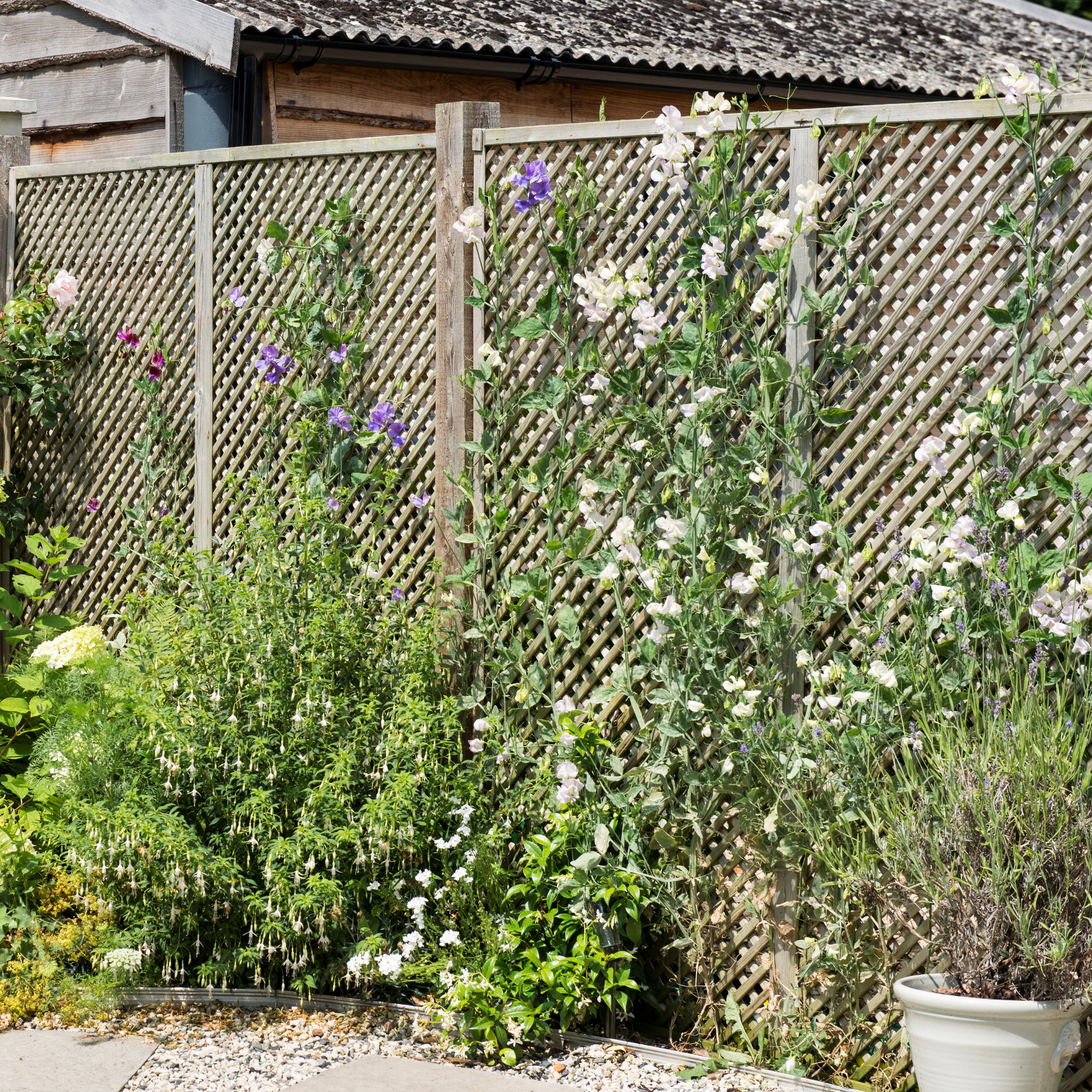
Garden fences aren't just practical – with a little thought and inspiration, they can add aesthetic appeal to your garden and even become a focal point. The right garden fencing ideas can transform your space into a beautiful retreat for you and your guests.
It doesn't matter if your garden ideas need to work with a small or big garden – there are a large variety of styles and materials to experiment with, from traditional wood to metal for a modern and contemporary look.
We've rounded up our favourite garden fencing ideas to help inspire your outdoor space.
Garden fence ideas
A good garden fence can provide structure and definition to your garden landscaping ideas, making it picture-perfect all year round. Your garden fence ideas aren’t purely for separating one garden from another but can set the overall character of the garden. ‘Giving your fence a touch of TLC is a great way to refresh your outdoor space,’ says Michael Rolland, DIY expert at The Paint Shed.
Take inspiration from these garden fence ideas to suit different styles and budgets.
1. Add a fence topper
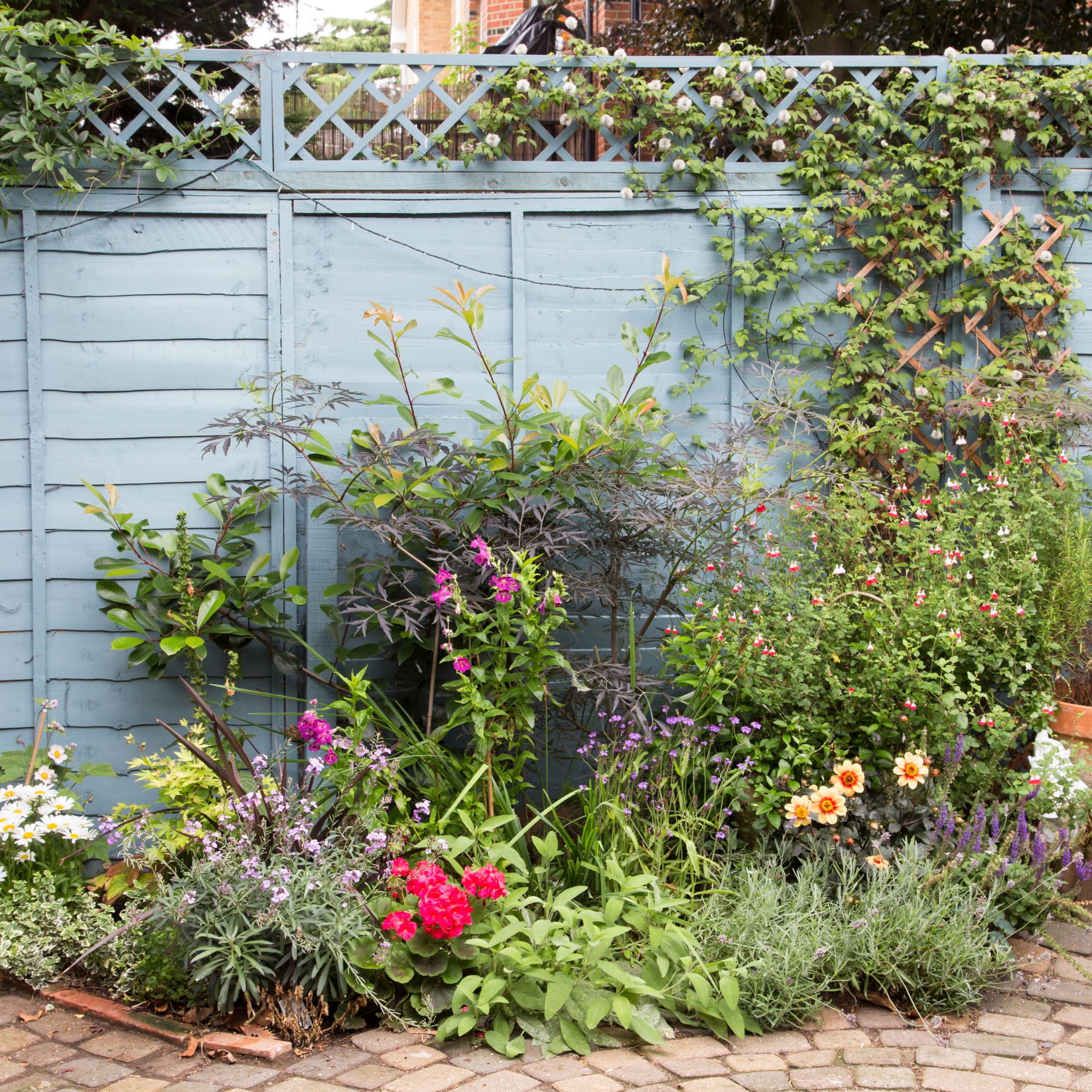
Fence toppers are available in a range of styles, from lattices to trellises, boosting the aesthetic appeal of regular garden fences.
'First and foremost, they can cost-effectively address a lack of privacy by adapting the fence you already have,' says Armstrong Cheshire's fence expert, Simon Wardle. 'However, the fence must remain under the 6ft legal height – unless you seek planning permission.
'Beyond privacy, they can add some cool features to the universal, uninspiring fences of the UK.'
2. Adorn with climbing plants
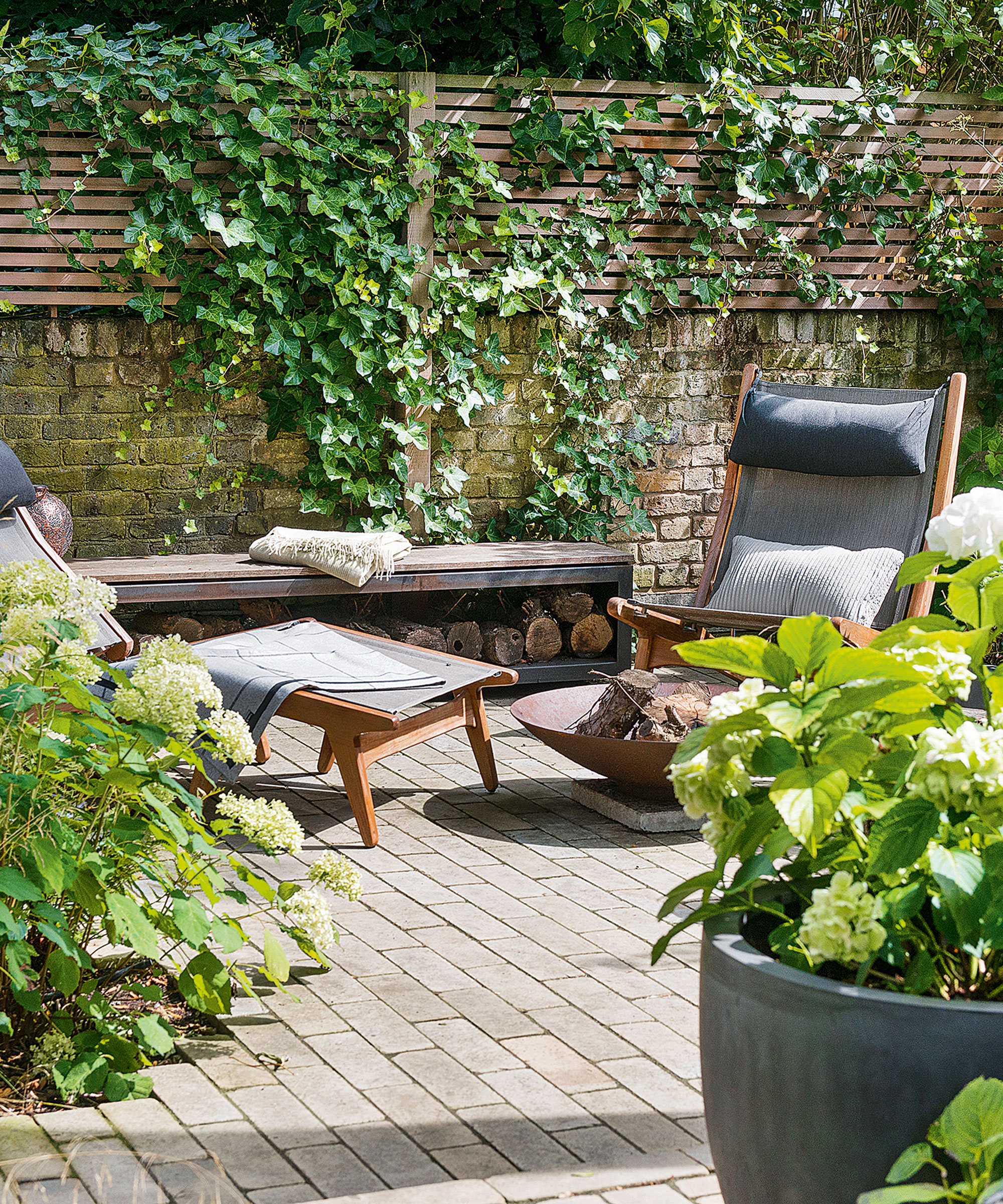
Training fast-growing climbing plants along your fence is a natural way of enhancing its aesthetics. Plus, if you've got an openwork fence topper, the plants can fill in the gaps for added privacy.
The options are endless when choosing which climbing plants to grow along your fence.
‘Don't forget about morning glory (Ipomoea purpurea),’ says Monique Gudgeon, garden director at Sculpture by the Lakes. 'This stunning twining plant produces great trumpet-shaped flowers of the bluest shade which appear every morning. In the sunniest position, it will quickly cover trellises, fences or arbours.
'Seeds are easily bought from garden centres and you can treat them in much the same way as sweet peas.’
3. Use stainless steel fixings
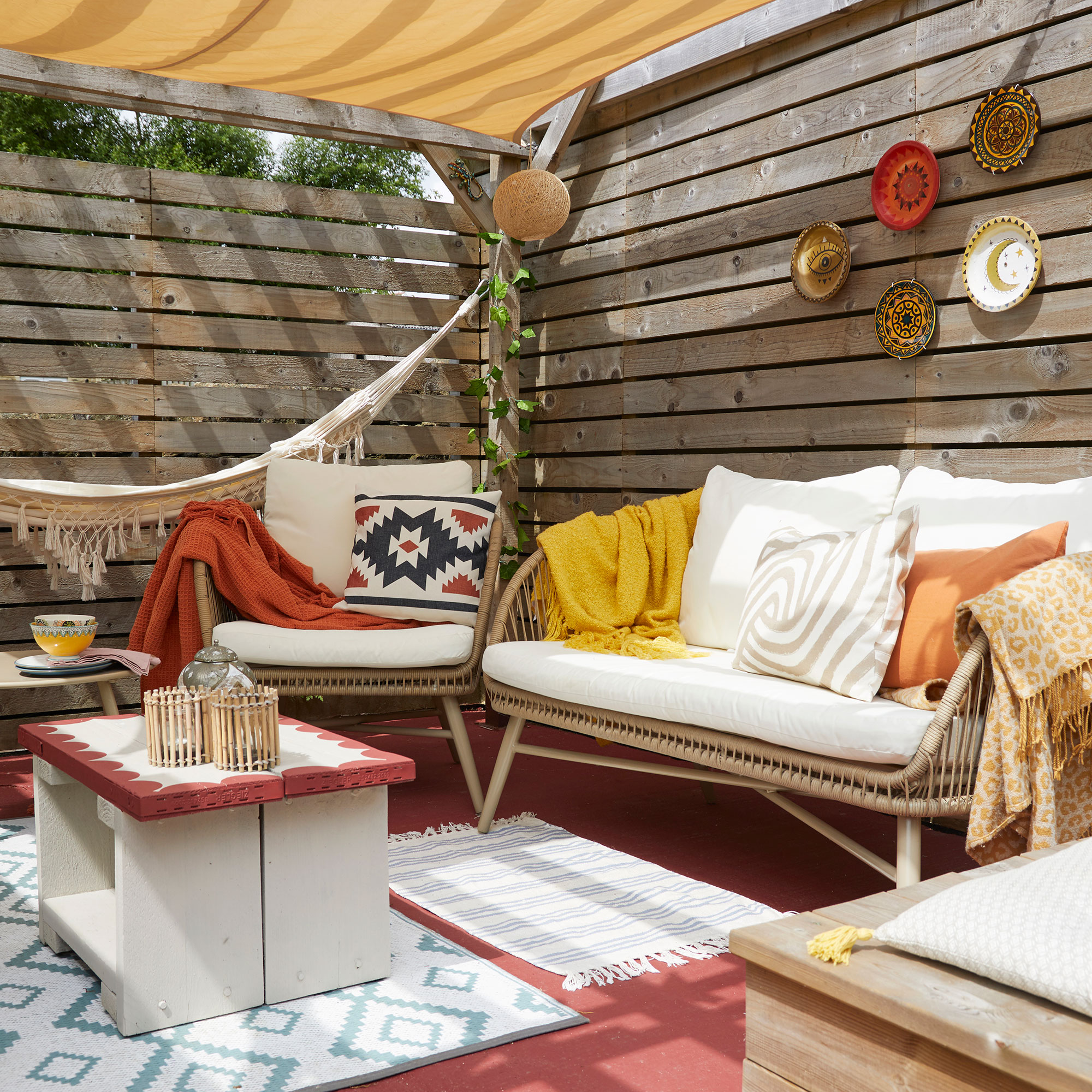
While it's easy to get swept up in the design of the fence itself, it's important to consider the smaller details for extra longevity.
‘Always look for stainless steel or galvanised fixings, says Leigh from Jacksons Fencing. 'If they are not used to hold your fence panel together, you will get awful rust marks running down your fence. This will ruin the look of your brand-new fence.'
Go for options like these Galvanised Brackets for Fencing Posts from B&Q for the best results.
4. Consider an accent fence
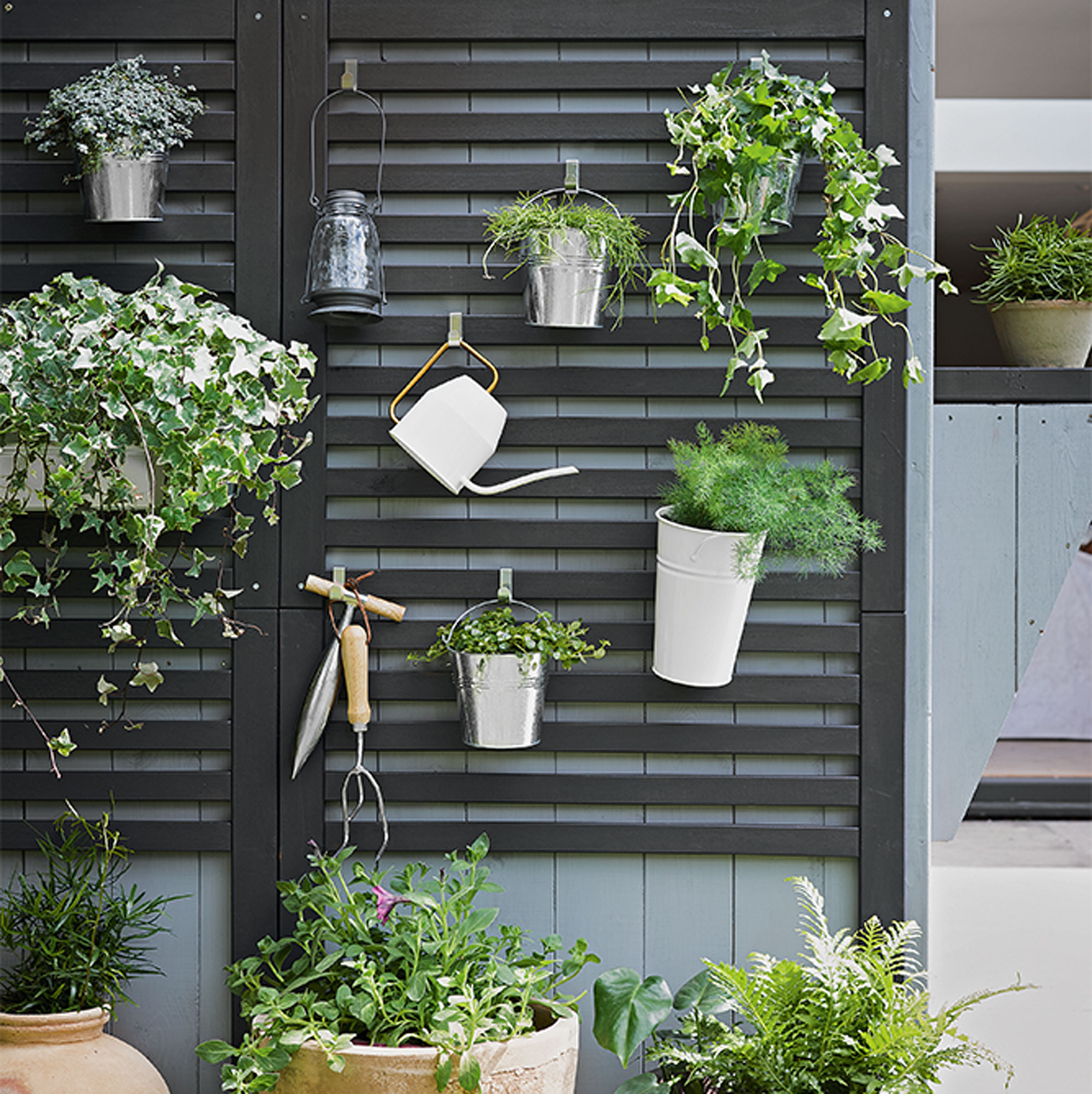
'Accent fences can be wonderful additions to your garden, adding both style and function,' says Leigh, retail sales manager at Jacksons Fencing. 'They can define spaces, create focal points, or provide a backdrop for plants.
'Consider using accent fences to highlight specific areas such as a flower bed, vegetable garden, or a seating area. Choose materials and designs that complement your overall garden aesthetic, like a decorative wooden trellis.
'An accent fence not only enhances visual interest but can also provide additional privacy or protection for delicate plants.'
5. Create a living wall
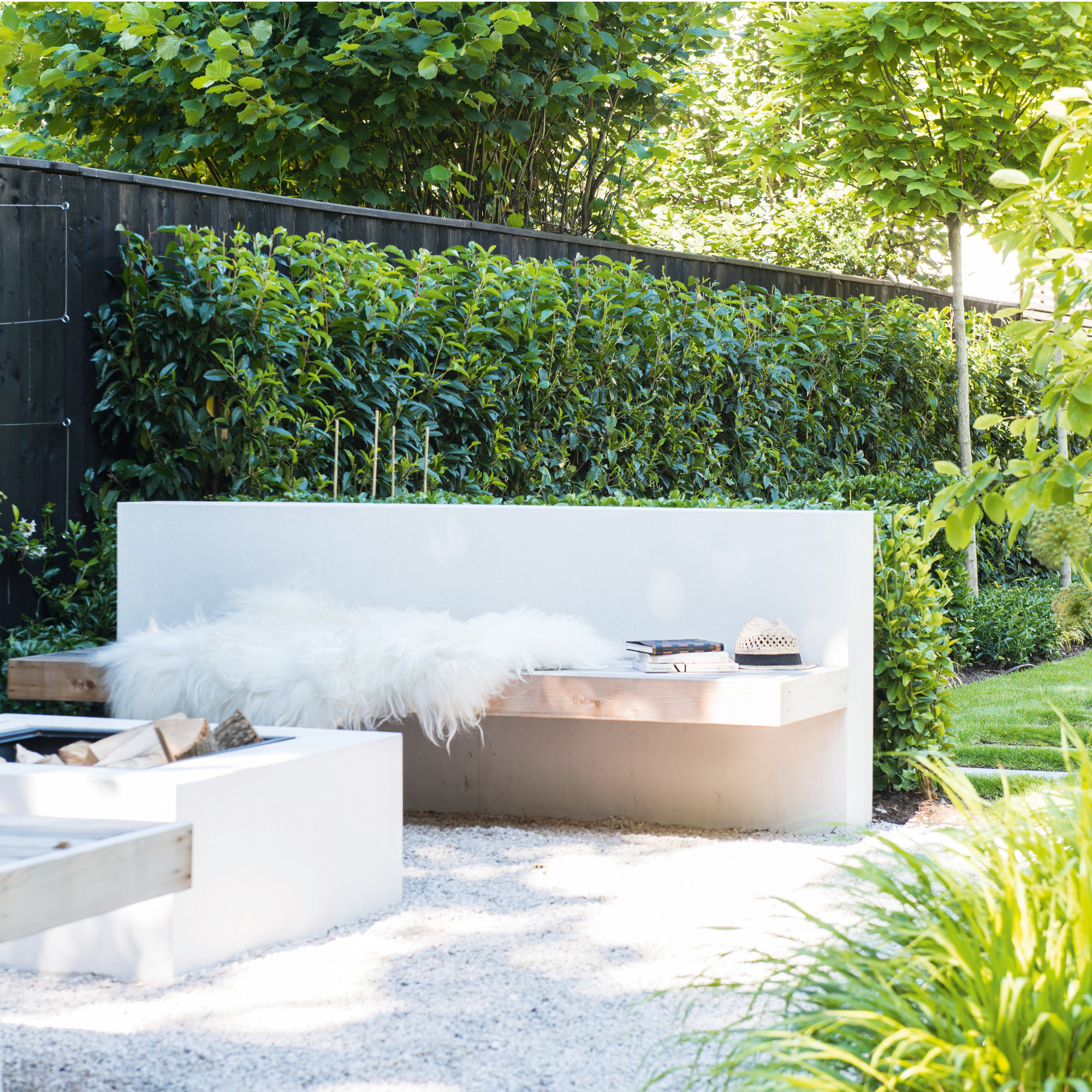
Instead of going for a standard fence, a pretty boundary can be created from a living wall for a natural fence of green foliage. This works especially well for small garden ideas because it adds greenery and interest without taking up too much floor space.
The living wall can be unique to your garden, incorporating flowers such as Vinca minor (lesser periwinkle) and Saxifraga x urbium (London pride) which work well with vertical planting.
Long grasses will add depth to your living fence and climbing ivy will cover any gaps you may have for a fuller look. If you want an easy garden idea, pre-planted modular panels give you a fence in full bloom with little effort.
Make sure to include a range of herbaceous perennials, grasses, herbs, seasonal flowers and scented plants. If you can't decide what to plant, ask your local nursery for advice.
6. Incorporate art with a mural

Art isn't just limited to inside the house – a mural on your fence is a fun way of adding colour to your garden. Using your garden paint ideas to make a mural will lift a bland garden scheme and provide an interesting focal point.
When painting a mural on your fence, choose bold colours which will enhance the nature in your garden. Think pinks, reds, oranges, blues and greens.
Before you start painting your work of art, give the fence a good clean and remove any flaking paint, moss or dust. With a wooden fence, certain areas may need to be sanded to give a nice smooth surface and any holes filled with wood filler. Protect your surrounding plants and grass by putting down an old cloth and prime a wooden fence with an acrylic base coat.
7. Light up your fencing

‘Festoon garden lights can be added along any garden fence for a touch of luxury, and are perfect for illuminating your garden all year round,’ says Tom Cain, technical engineer at UltraLEDs. Garden lighting ideas along your fence not only look good but are an easy way to light up steps and paths in your garden to keep it safe at night.
‘The twinkling bulbs can add a playful and celebratory atmosphere to any garden party, whether you’re marking a special occasion or just hanging out with friends and family. Festoon lights have many benefits, including energy efficiency, durability and safety. In fact, one LED bulb is so energy-efficient that it can last up to 50,000 hours, benefitting both your wallet and the environment.’
If you do string LED lights along your fence all year round, they need to be suitable for all kinds of weather. Make sure they have at least an IP44 rating, like the 4lite Outdoor LED Weatherproof Festoon String Lighting from Amazon, so the lights are protected against light rainfall. If you expect heavier rainfall, choose a higher IP44 rating.
8. Use fencing as a background for seating
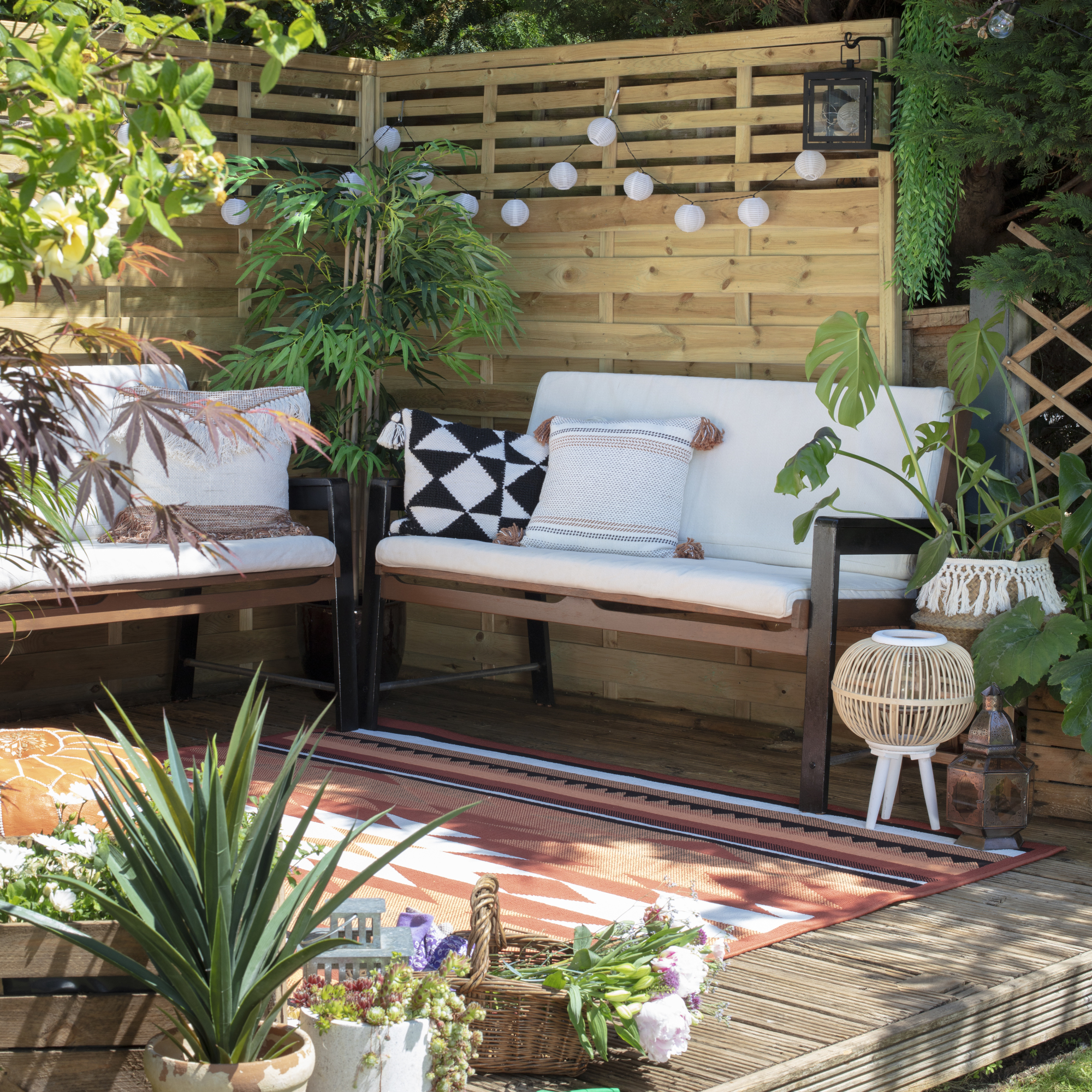
If you are lucky to have enough space for a separate garden seating area, use the fence to cocoon it to create your own private seating zone. Placing your seating in a corner with a fence on two sides creates a mini ‘room’, extending your living space out into your garden. Having the fence surround your seating area not only provides a comforting boundary but also provides added privacy from any nosy eyes.
‘Plant the fence up thickly with evergreen and herbaceous climbers which flower at different times of the year,' advises Angela Slater, gardening expert at Hayes Garden World. 'Try and make sure there is a constant supply of colour.’
9. Use deconstructed pallets to make a fence
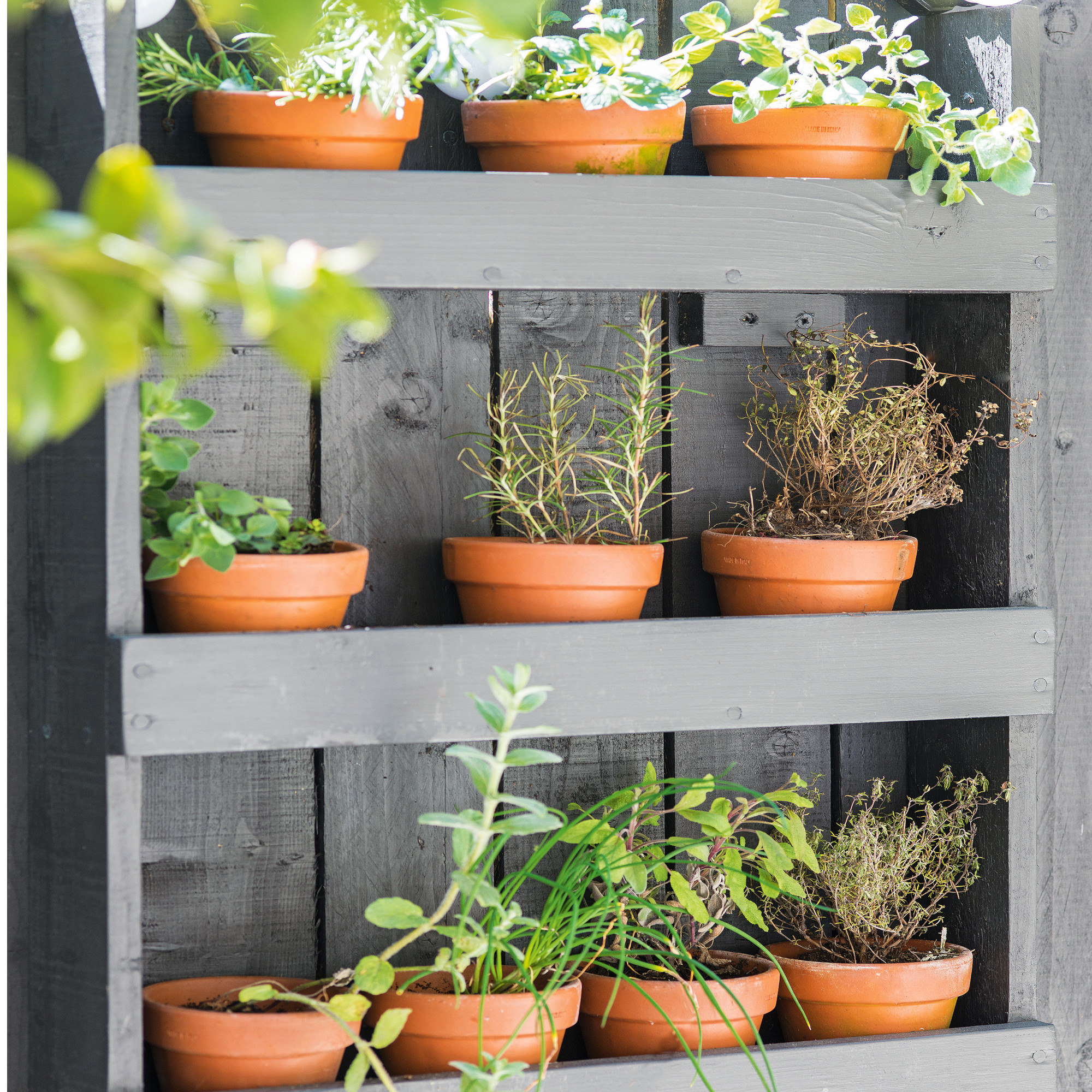
For a budget garden idea that will not only provide a solid structure but will get you hands-on with your garden fence ideas, create your fence from pallets. Pallet ideas for the garden are eco-friendly ways of giving old wood a new lease of life as fences.
‘Deconstruct pallets and use the boards to make a fence,’ says Angela from Hayes Garden World. ‘However, they do need a post and rail frame on which to nail them. For added interest, instead of nailing on the boards in a vertical position, fasten them on at a slant or place the boards horizontally for a contemporary look.
'Deconstructed pallets do involve a little work; as they are just rough timber, they do have to be sanded down. They also need to be protected against the elements otherwise they will soon start to rot.'
Wood pallets provide stable and resilient fencing material and can be picked up very cheaply or sometimes for free from local businesses. Using leftover pallets for your fence prevents them from ending up on a rubbish heap and adds a rustic twist to your garden.
10. Place shelves on your fence

A fence with shelving provides you with not only a boundary but also somewhere for extra storage and decoration. Shelves can maximise your garden storage ideas by holding regularly used garden tools. Or, you can place decorative potted plants on them.
‘Shelves can provide you with a lot of unique possibilities. You can use the shelves for bird feeders or attract insects like butterflies. You could even create an outdoor kitchen area with shelves incorporated,’ says Thomas Goodman, property expert at Myjobquote.co.uk.
If you love entertaining, use the shelves as somewhere for people to perch their drinks or plates of barbecued goodies.
11. Create a mixed hedge boundary
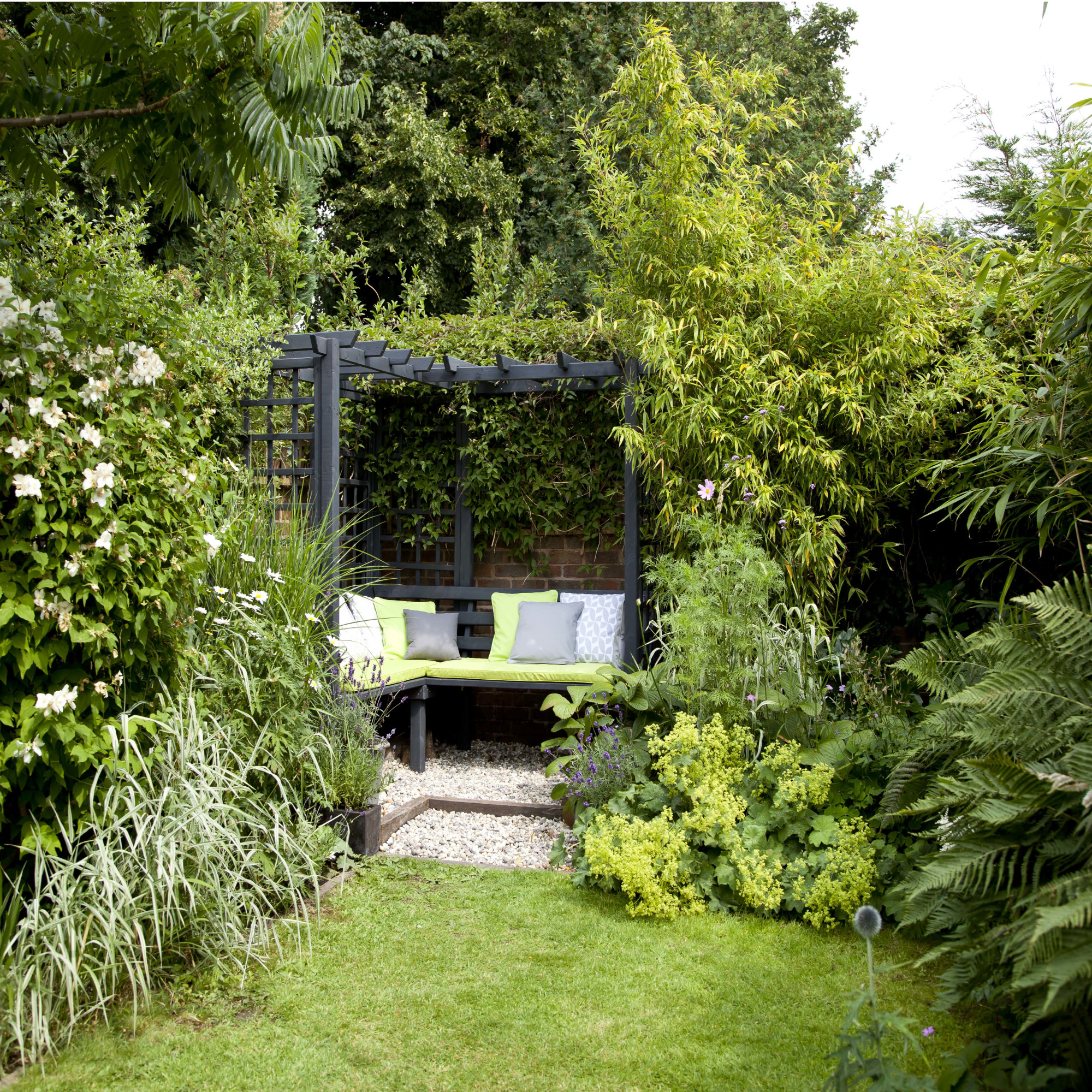
Mixed hedges provide seasonal colour to your fence all year round, and will blend in with the rest of your garden greenery. When looking at garden border ideas, hedging is a great option.
‘Growing a native mixed hedge can provide privacy, security, if you include thorny shrubs, and food and shelter for birds and small mammals,’ says Angela Slater from Hayes Garden World.
Mixed hedgerows provide both a nesting cover and a diverse source of food for animals, bringing a mix of wildlife to your garden. If you are a beginner at gardening, creating a mixed hedge fence is easy to maintain and grow because it suits a wide range of soils and climates. Unlike a single variety hedge, a mixed hedge will give you a variety of colours, shades and shapes.
When thinking about which plants to incorporate in your hedge, Photinia is an evergreen plant that has vibrant red leaves, lilacs will offer a lovely fragrance, and Sambucus has white flowers and produces black fruit.
12. Break it up with bamboo
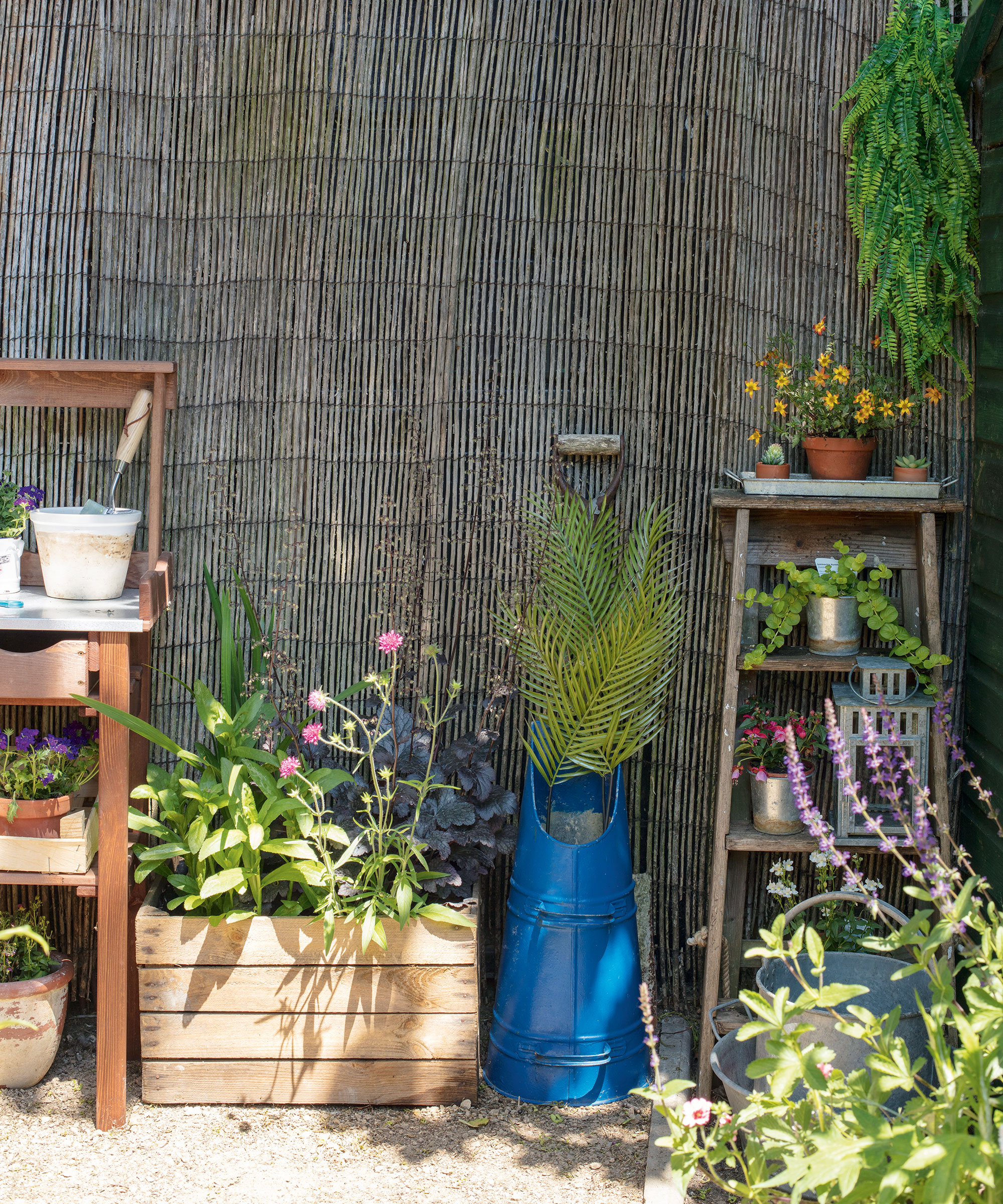
Garden fences aren't just used along the boundaries of your space – they can also be used to zone different areas within your plot.
Bamboo screens are great for this as they are lightweight, so you can install them yourself. Plus, they have a malleable quality to them, making them great for all spaces. They can also be cut to the size you need, and any off-cuts make lovely flower bed borders.
Angela Slater from Hayes Garden World says, 'Woven bamboo panels are a relatively inexpensive form of fencing, but they do need a secure framework. Living bamboo plants make a quick-growing green fence – just make sure you don’t buy the invasive varieties.
'Sink slates on their edge around the space where you want the bamboo to grow – they are fairly shallow rooted and won’t go underneath the slates but will stay contained within their allotted area.'
13. Take it back to black
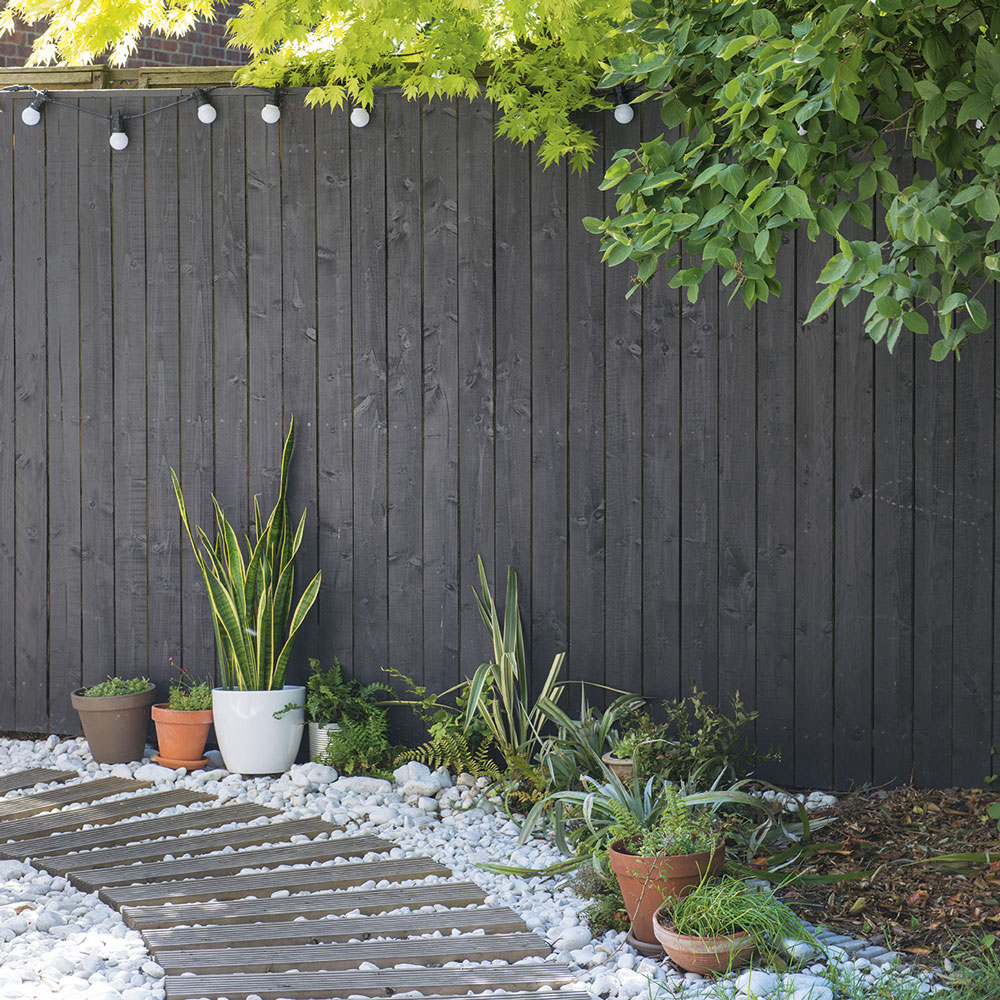
When considering how to paint a fence, black might seem like a bold choice for garden fencing, but painting yours in this shade will actually make the plants around it seem greener!
Fresh green shades up against the black of your fence will make them stand out even more and give a contemporary look. Finish the look by hanging a string of fairy lights along the top, which at night will create a cosy glow against your fencing.
14. Pop up a potting bench
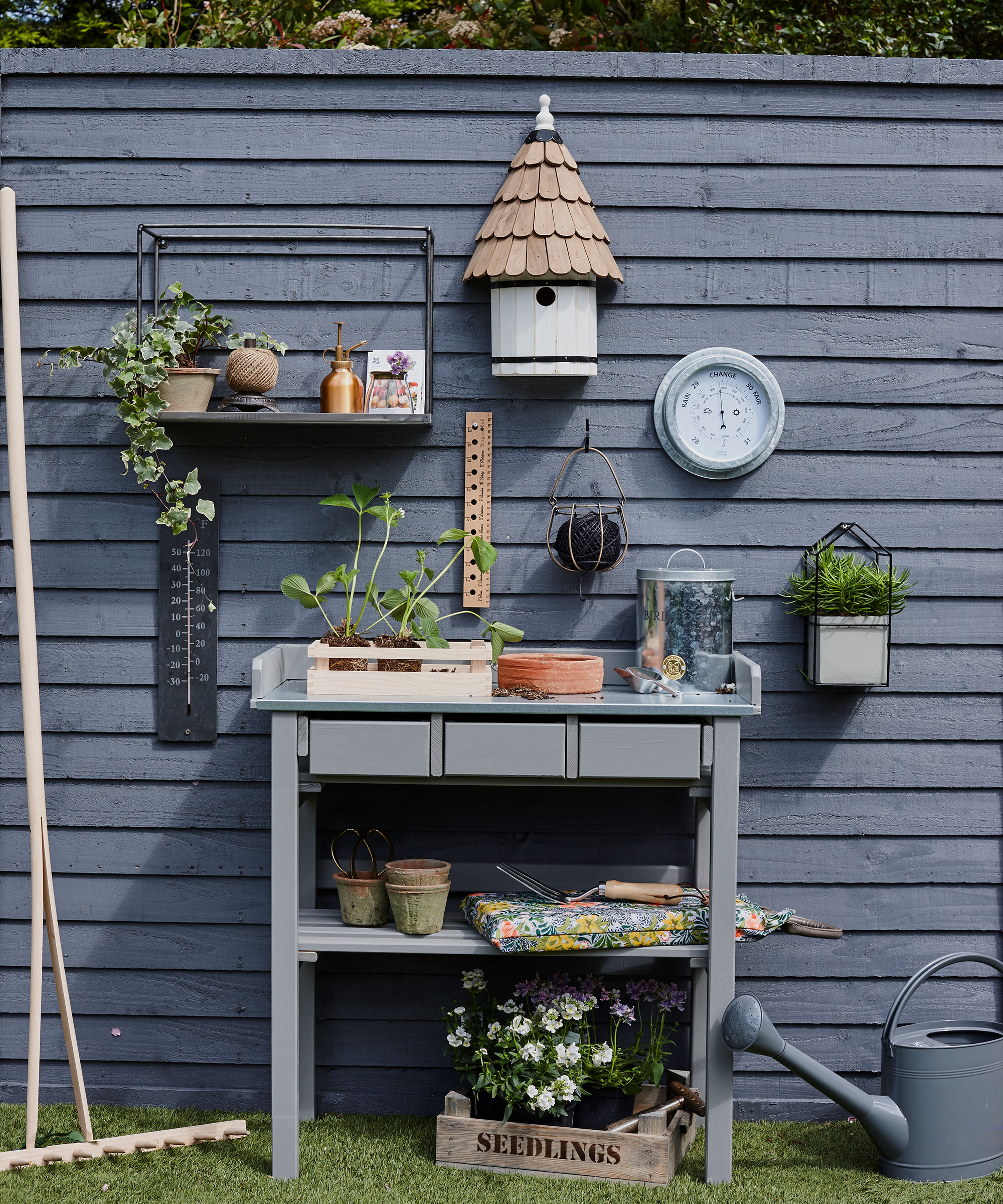
Turn your garden fencing into the backdrop for a potting station. Instead of your garden ending with just a solid fence, break it a bit by setting up a potting bench and work station to enjoy all summer long. Fixing up a couple of shelves will give you space to display potted plants and garden accessories.
15. Echo your fencing around the garden
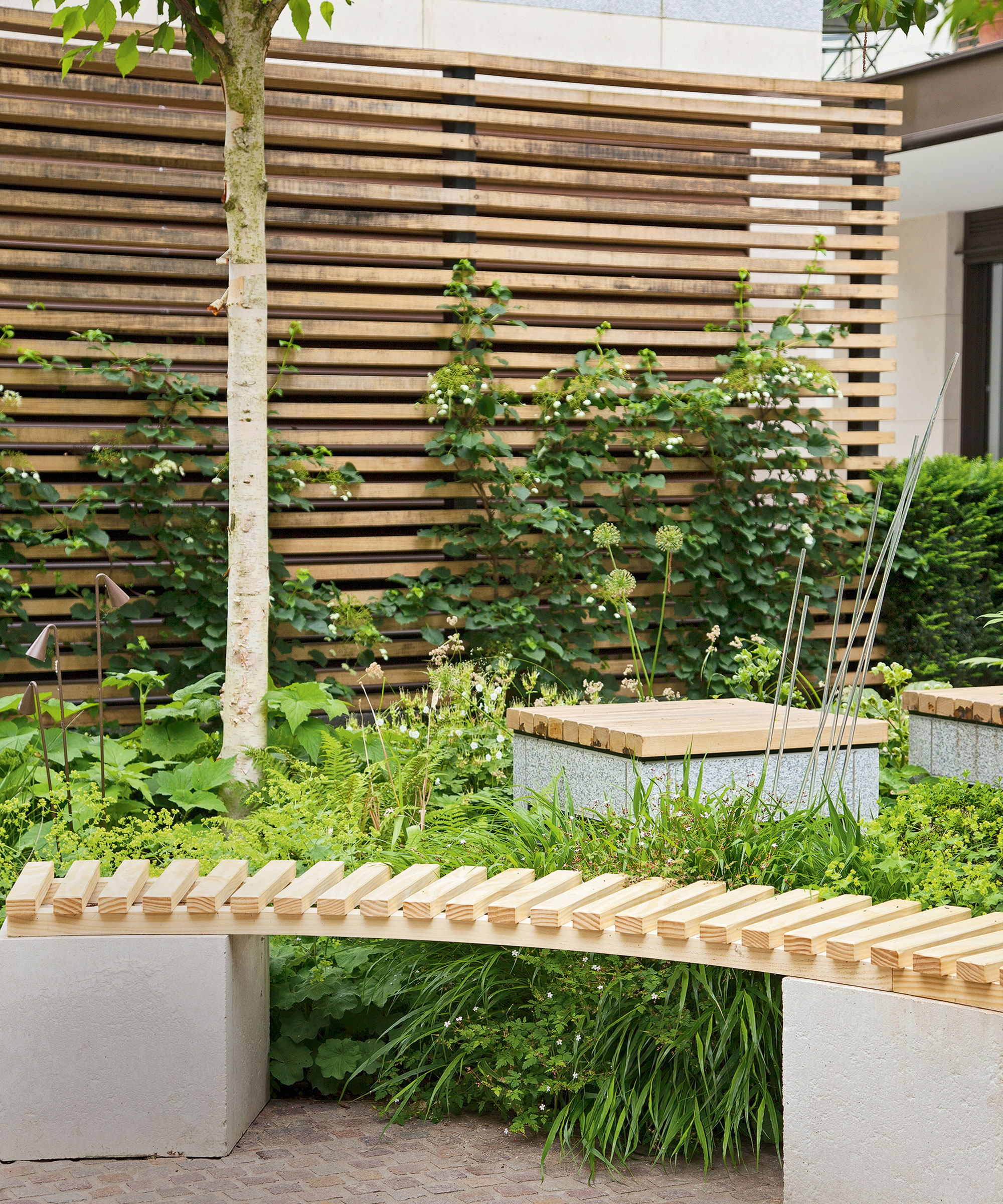
If you have chosen contemporary fencing that creates a feature in your garden, why not echo that feature in other areas, too? Here, the homeowner has made a bench with similar slim panels of wood to the fence behind, tying the whole space together. Thin, horizontal slats of wood are a modern, fresh look for fencing and, whether painted or left bare, they're perfect for courtyard gardens and turf-covered gardens alike.
16. Take it up a level
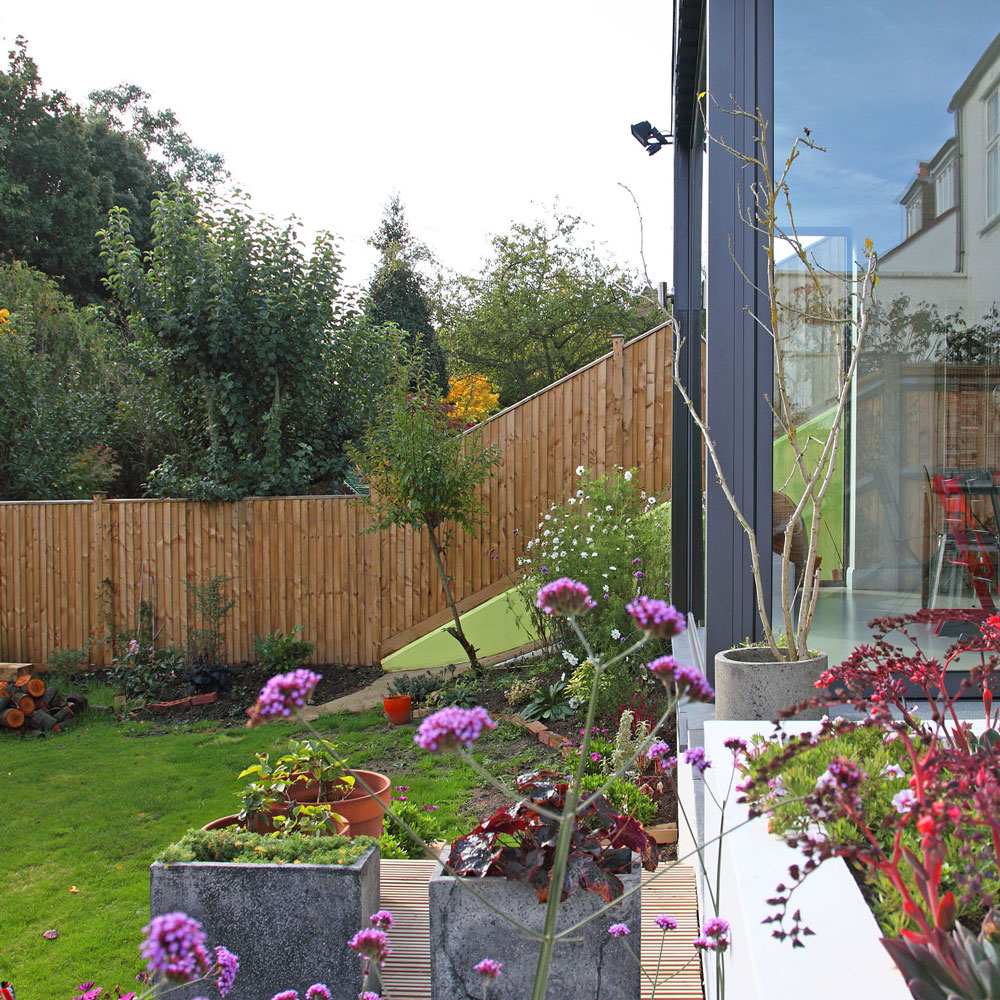
Use traditional lap fence panels to align the different levels of the perimeter of a garden. Run the design alongside an incline or stepped paving to create a continuation of the fence, rather than adding different height levels which make it feel disjointed.
Rather than staining or painting the panels, simply seal them with a coat of wood-preserving varnish for an understated finish.
17. Paint a feature wall
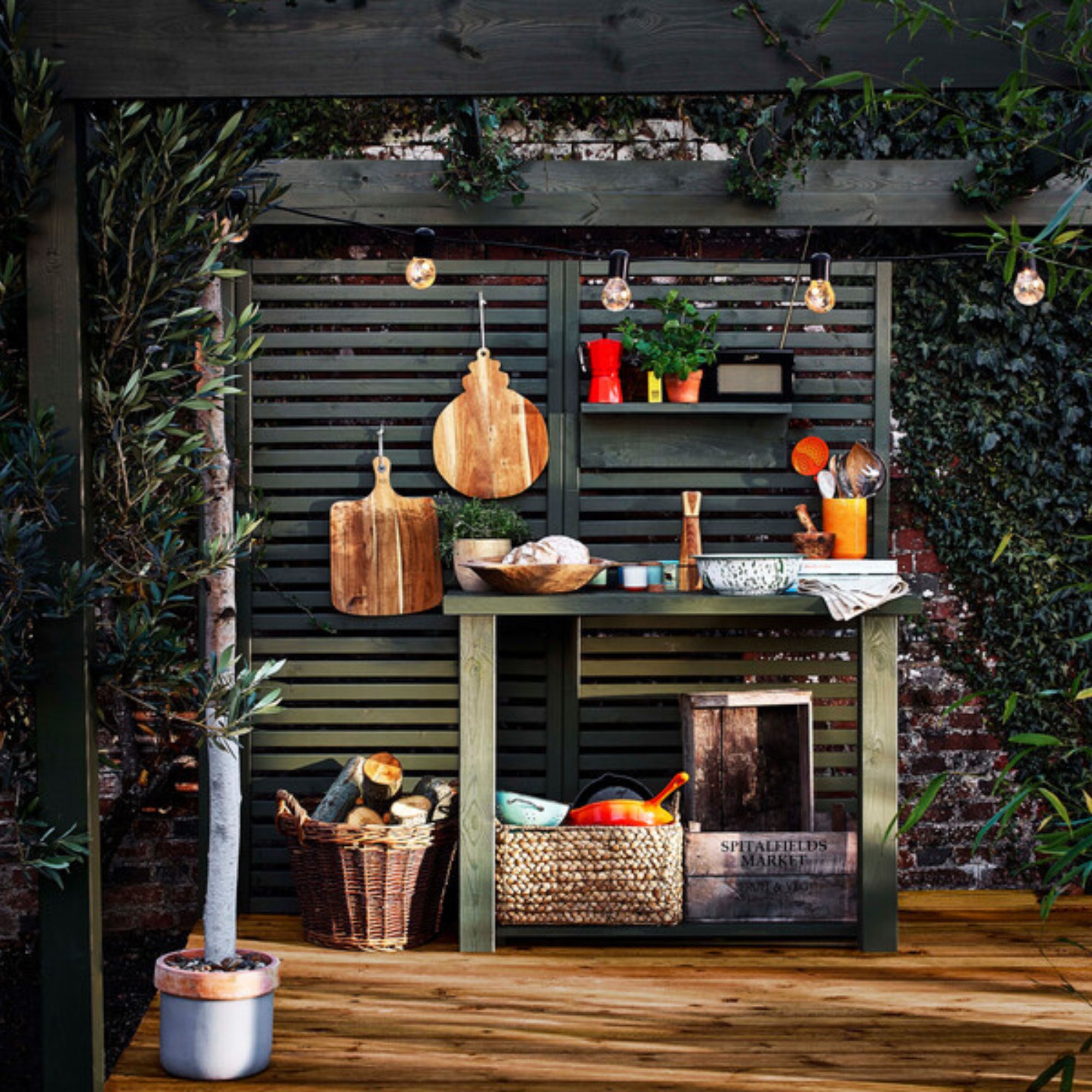
Update an old fence to match new season trends with a splash of paint, creating a feature wall within your garden. A clever garden paint idea is to create an ombre effect by choosing several colours in the same paint family. Cuprinol Garden Shades, available at B&Q, have the added benefit of weatherproofing your fence.
18. Make a playful statement with a two-tone panel
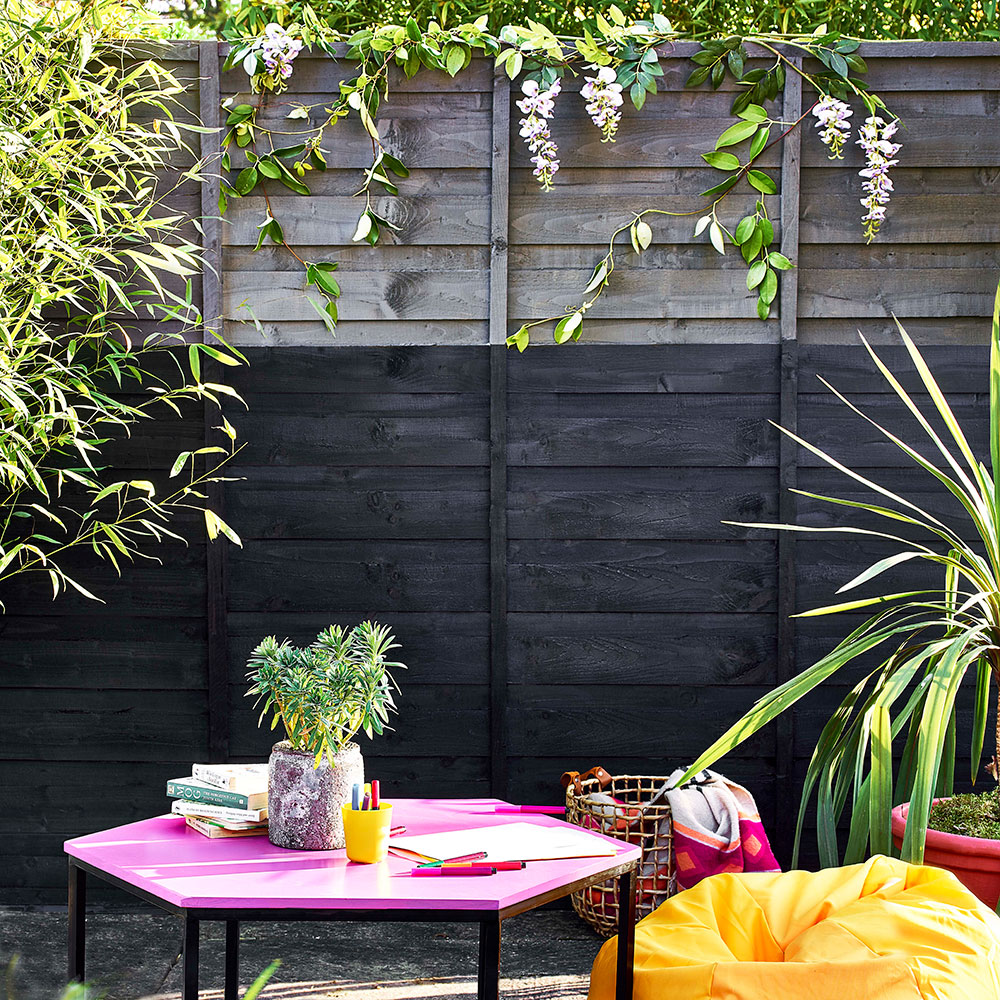
'Create a striking look for your fence in two tones,' says Marianne Shillingford, creative director at Cuprinol & Dulux. 'Keep the darker colour at the bottom to show off brightly coloured furniture and to make floral arrangements pop. All it takes is a bit of masking tape to get a sharp line between the divide.'
19. Soften the look with slatted fencing

If your property is not overlooked, you may not wish to erect solid fence panels. The slatted fence is a softer approach to setting the boundaries of a garden, without making it feel enclosed.
The slim gaps between the slats allow a glimpse of the greenery beyond, in a sense extending the view of the garden while still framing the grounds.
20. Repurpose old shutters as fences
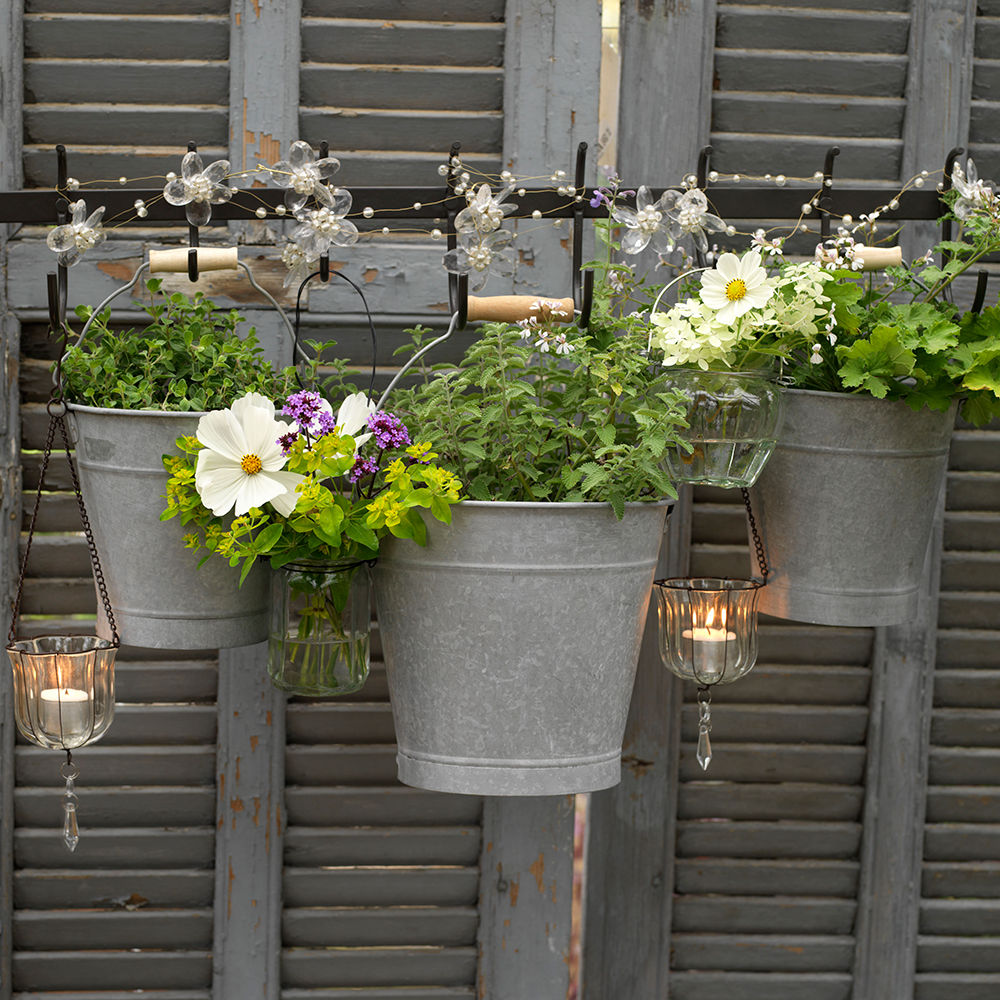
Create an innovative garden fence that has plenty of eco credentials by repurposing old shutters.
Start by giving the shutters a coat of paint. Grey is a good colour for a backdrop, as it goes with almost everything, but white would look fab, too, especially when it starts to become rougher and less pristine.
Add hooks to your shutter fence and use them to display pretty potted plants. Buckets work well, as their handles make them easy to hang.
21. Create privacy with a fence extension
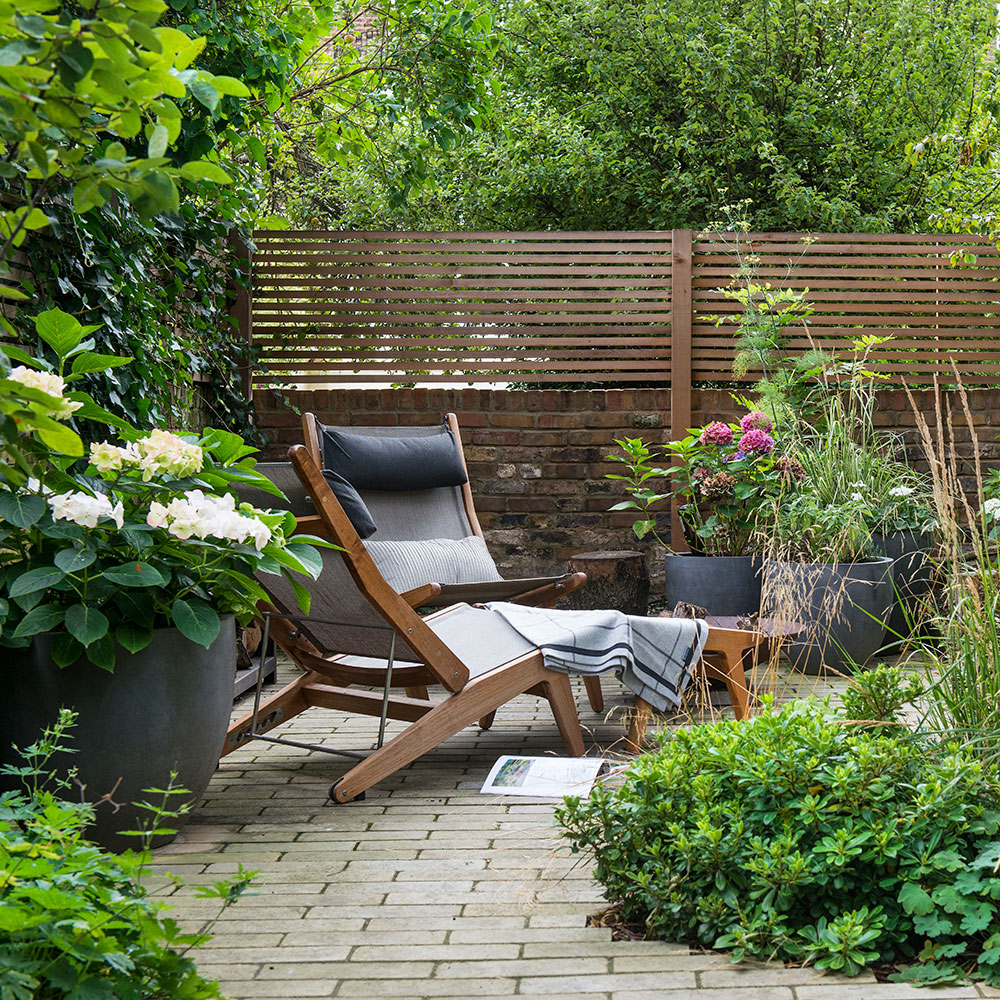
This beautiful low wall has so much character, it would be a shame to cover it up with full fence panels. Equally, building it higher to give the owners more privacy would be costly and could make the space feel too institutional.
This fence 'extension' has been carefully selected in a colour that complements the brickwork, and its horizontal slats have a contemporary feel to chime in with the landscaping's mix of traditional and modern.
22. Mount on an outdoor kitchen
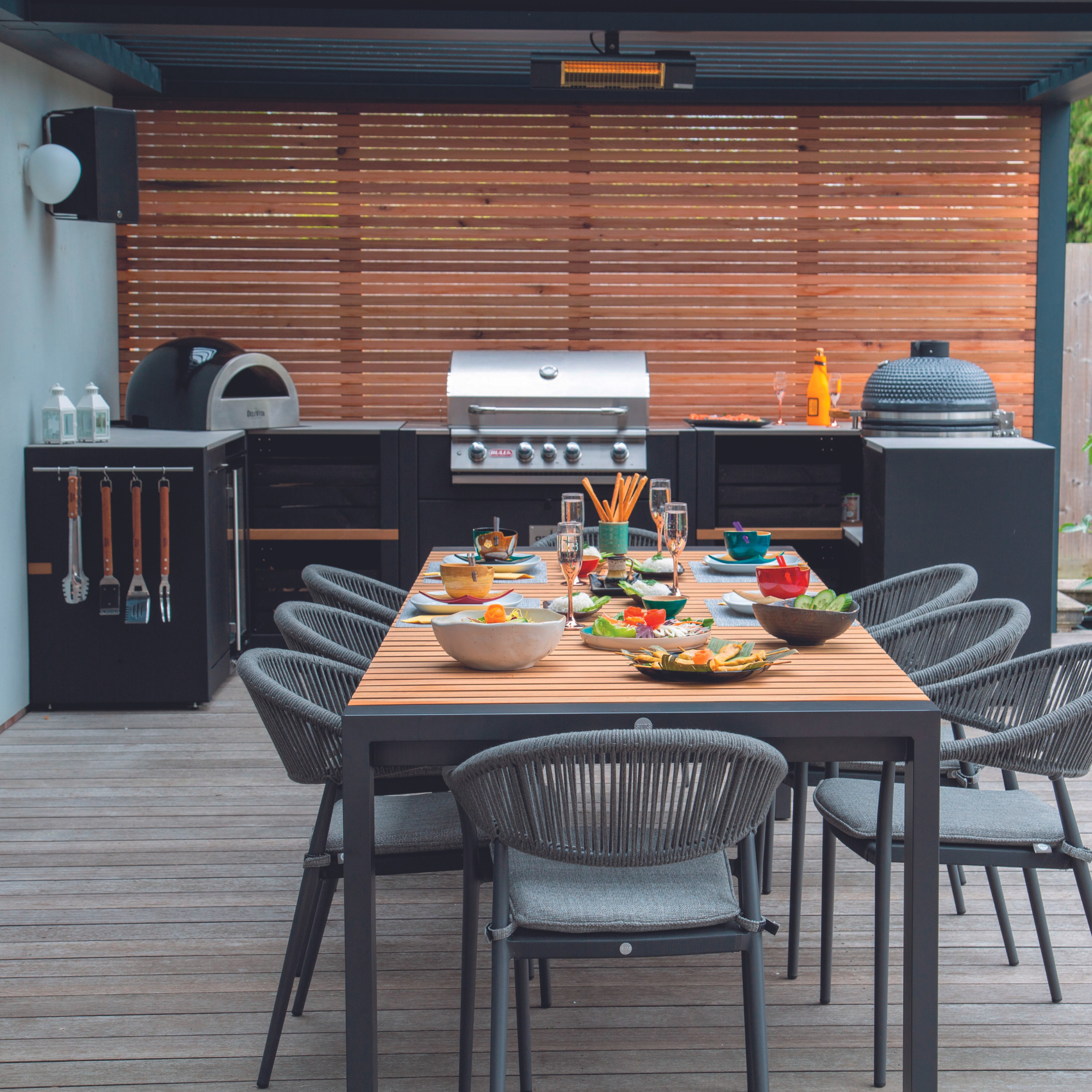
A slatted fence panel can be so much more! By adding a protective pergola above, a countertop and a shelf for storage, you can fulfil your small outdoor kitchen ideas for next to nothing.
A little imagination, basic DIY skills and some timber can go a long way – add baskets for storing pots, pans and fuel for your outdoor cooker, and hang festoon lights so that you can cook well into the evening.
23. Camouflage in green
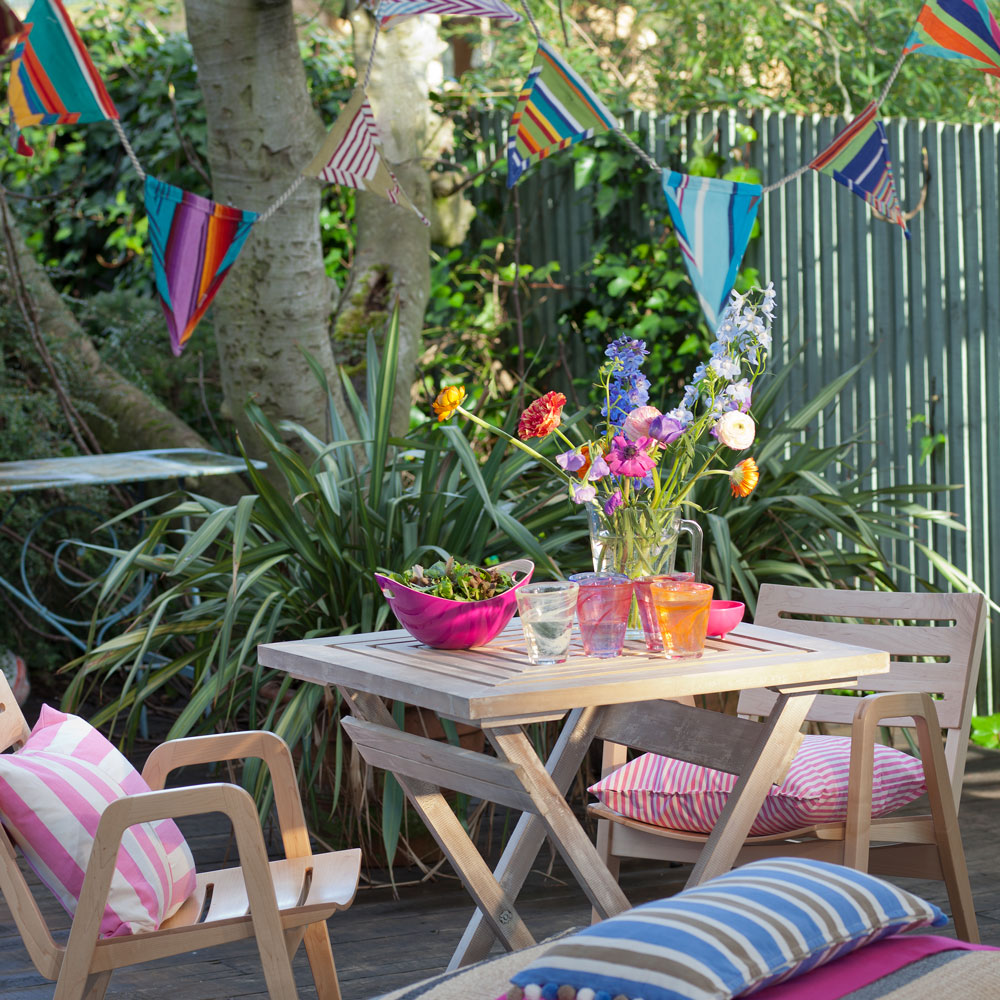
If you don't want your garden fence to stand out from the crowd with bold colours, make it blend in with a coat of green paint. A serene shade of green can help a garden fence camouflage into the foliage.
You can add colour through other mediums, from a string of decorative bunting to jolly striped outdoor cushions.
24. Go for an on-trend grey fence
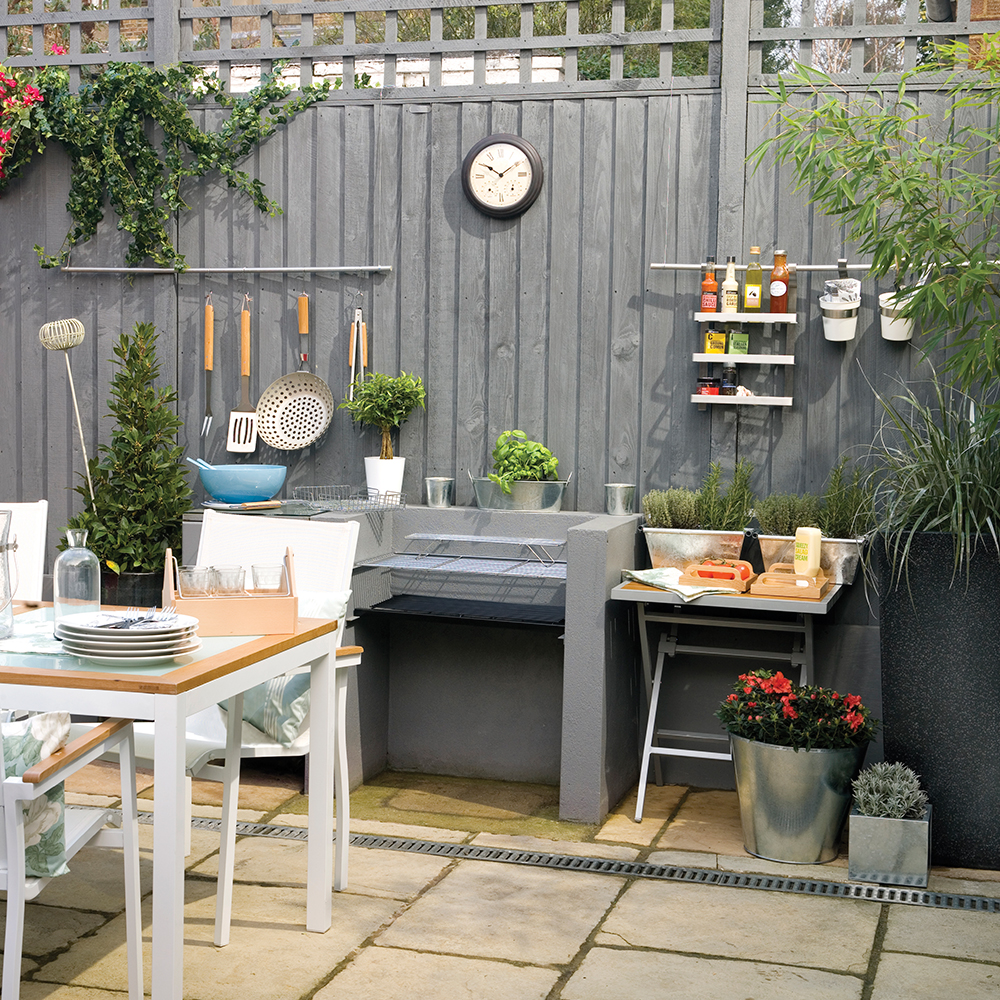
We love this grey fence – it provides a chic backdrop to the outdoor kitchen area and looks classy against the white shelving and hooks.
Simple accessories like an outdoor wall clock and potted plants make a real feature of the fence.
25. Open the boundaries with rustic willow materials
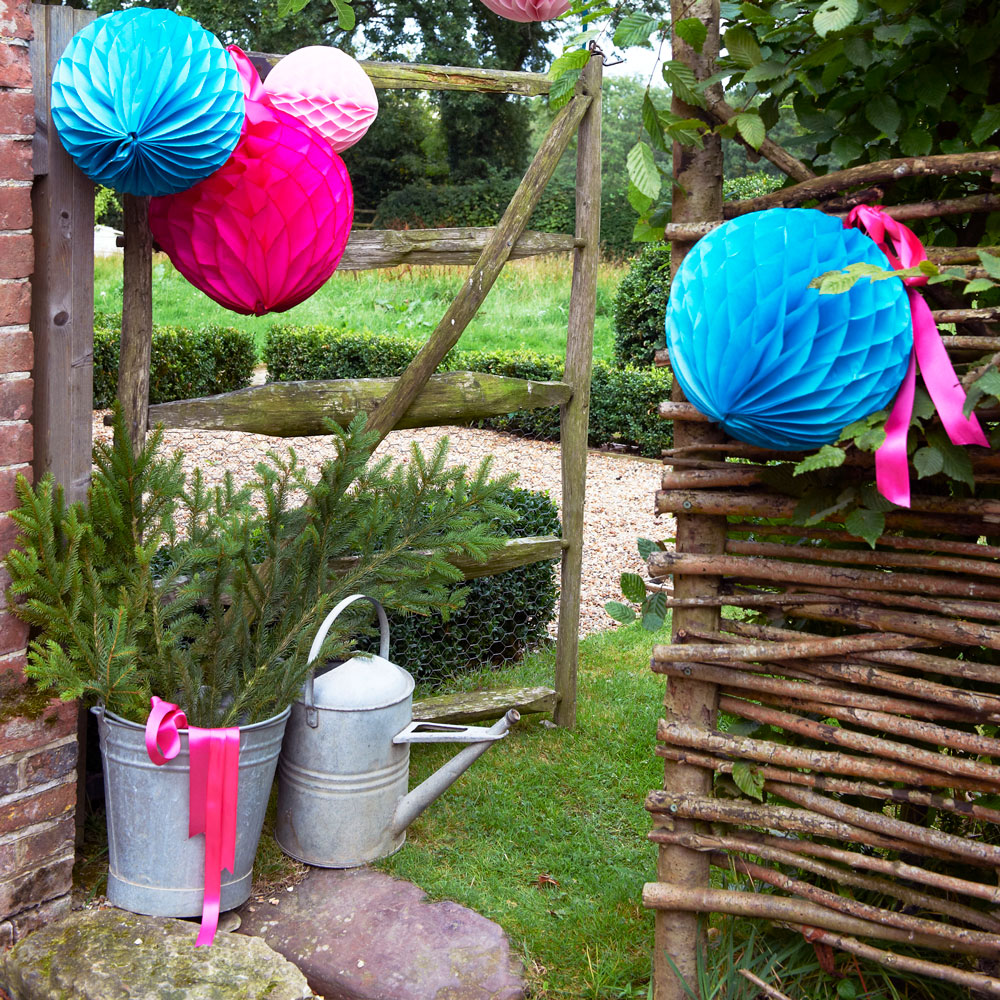
To prevent a garden fence from feeling too imposing or constraining, it's an idea to use rustic materials to break up the design.
A willow twig fence design is given a softer edge thanks to infilled panels of chicken wire, providing a secure design but allowing a view-through. Use this for the door and gates, teamed with willow woven fence panels for the main fenced area.
26. Decorate your garden fence with colourful tealight holders
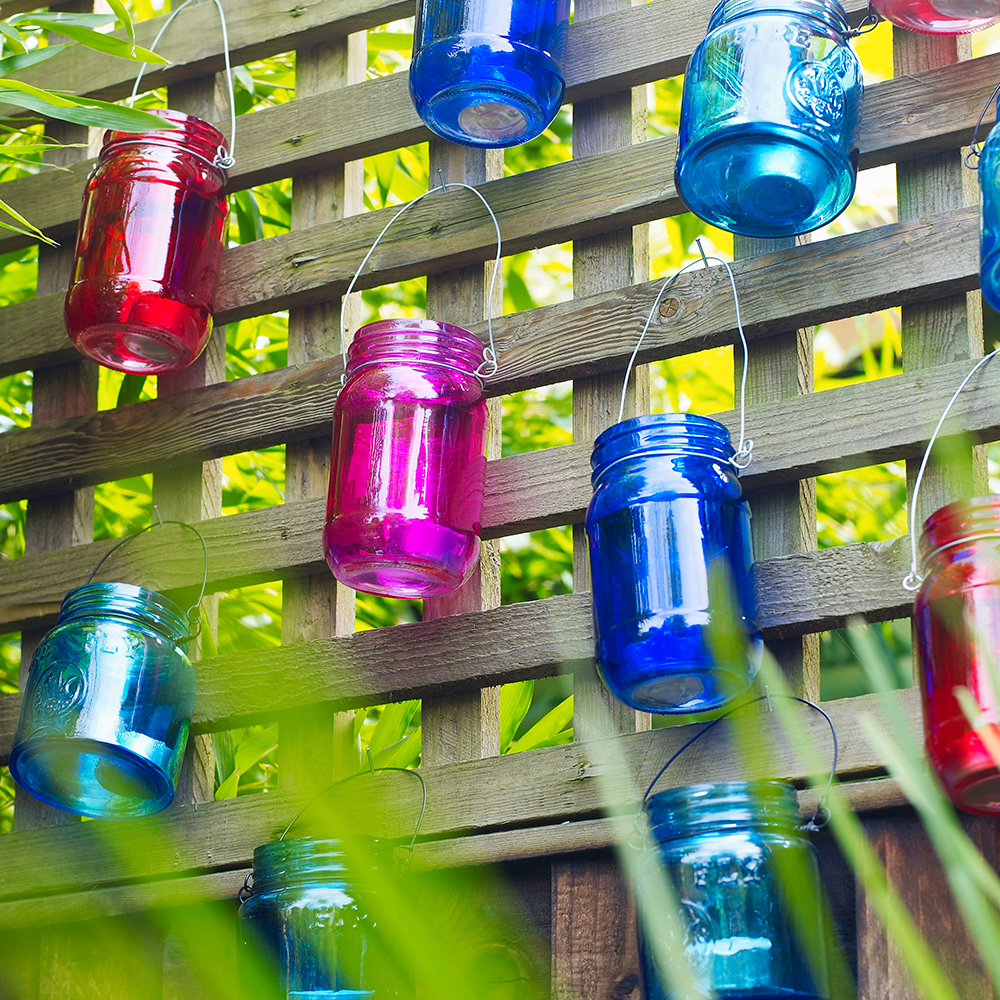
Take a garden fence with a trellis top and jazz it up with jam-jar-style tealight holders that look super pretty even during daylight hours.
Use secure but unobtrusive nails to hang them so that they almost look like they're floating. A variety of shades will work well, but clear jam-jar tealights would also look great. At night, enjoy their warm glow from the comfort of a nearby garden chair. Bliss.
27. Create a secluded dining area with willow fencing
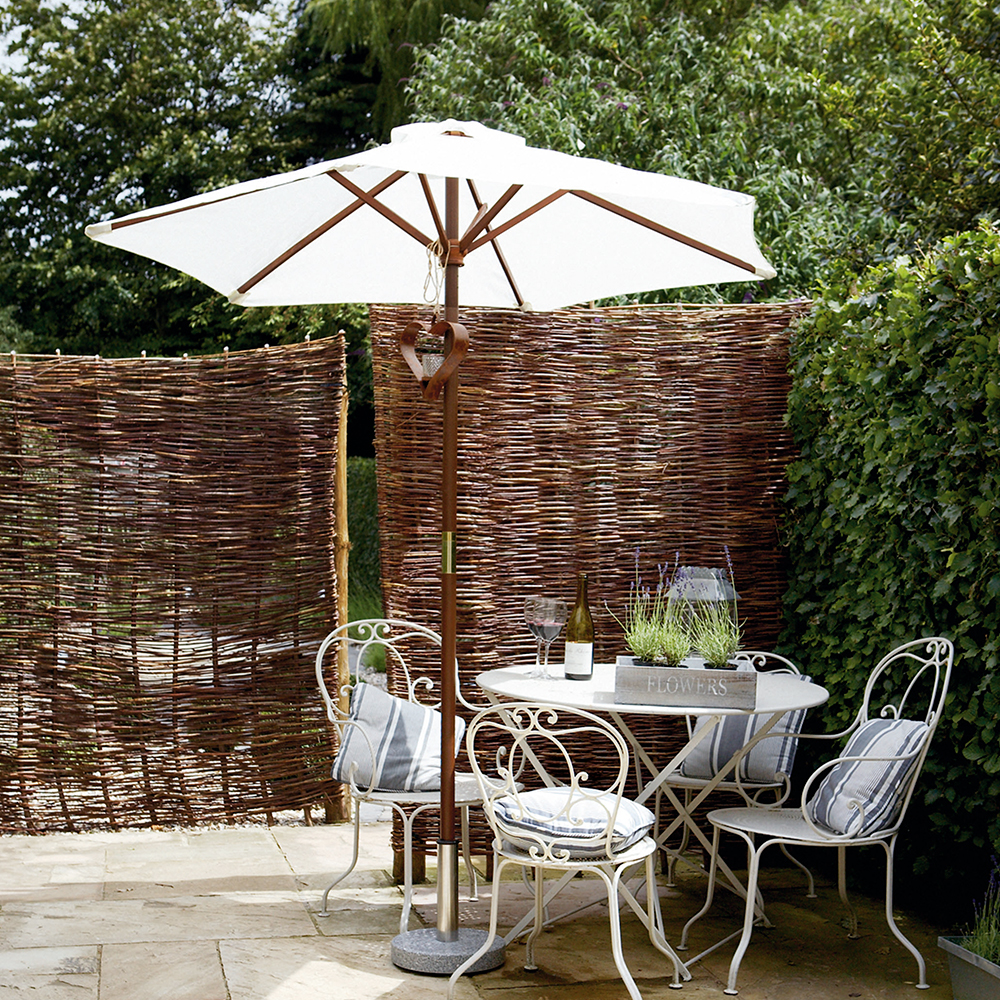
Go for an extra high garden fence to provide all the privacy you could ever need – especially if you have curious neighbours.
This fence features narrow lengths of willow that create a bamboo-style effect, ideal for screening an existing fence if you don't want to start completely from scratch. Willow screening fence panels can also add height to a short wall or fence, or you could even use it to keep the compost heap hidden from view.
28. Opt for a modern, low horizontal design
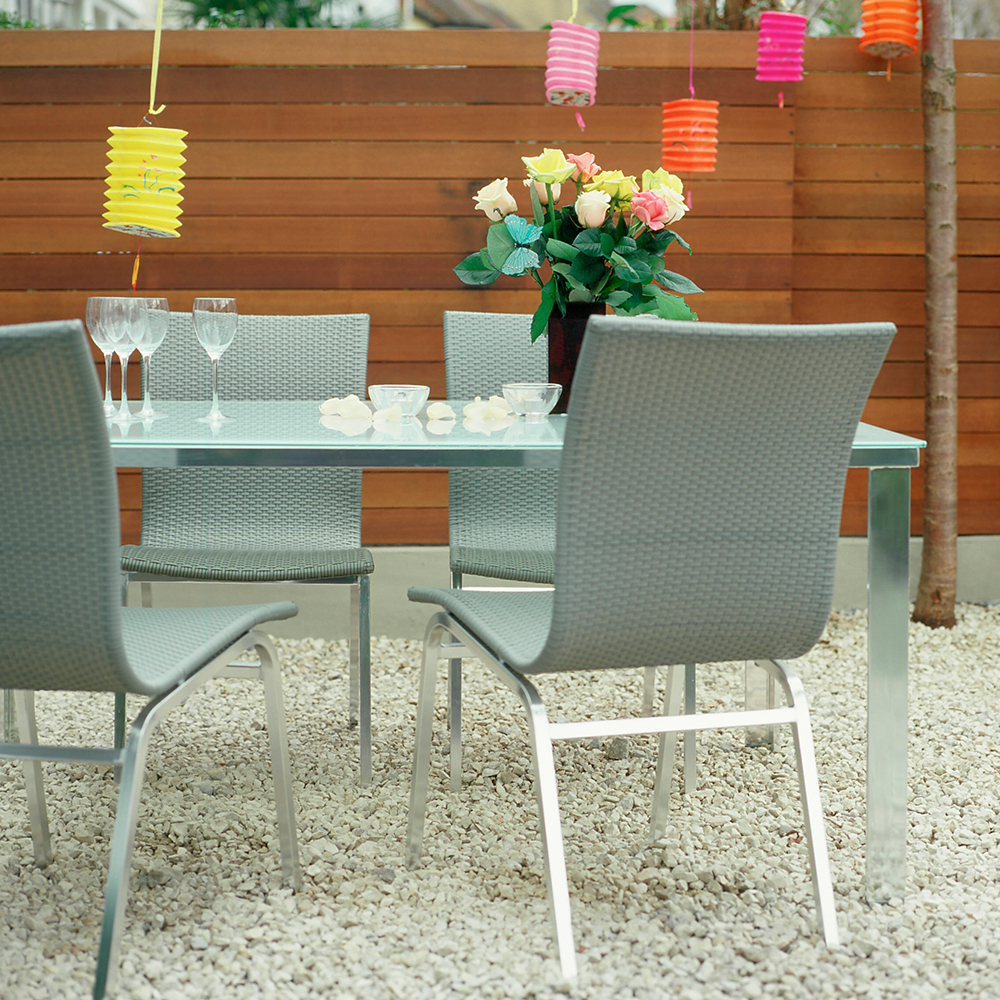
Mount a wooden garden fence on top of a concrete border for an elegant and modern scheme that has the feel of a room complete with a 'skirting board'. Not only does this contemporary garden fence look great, but it will also keep the gravel neatly in place. Go for horizontal wooden panels so that everything flows in a similar direction. A smart mid-toned varnish will be the perfect finish.
29. Mix your materials to create an unique look
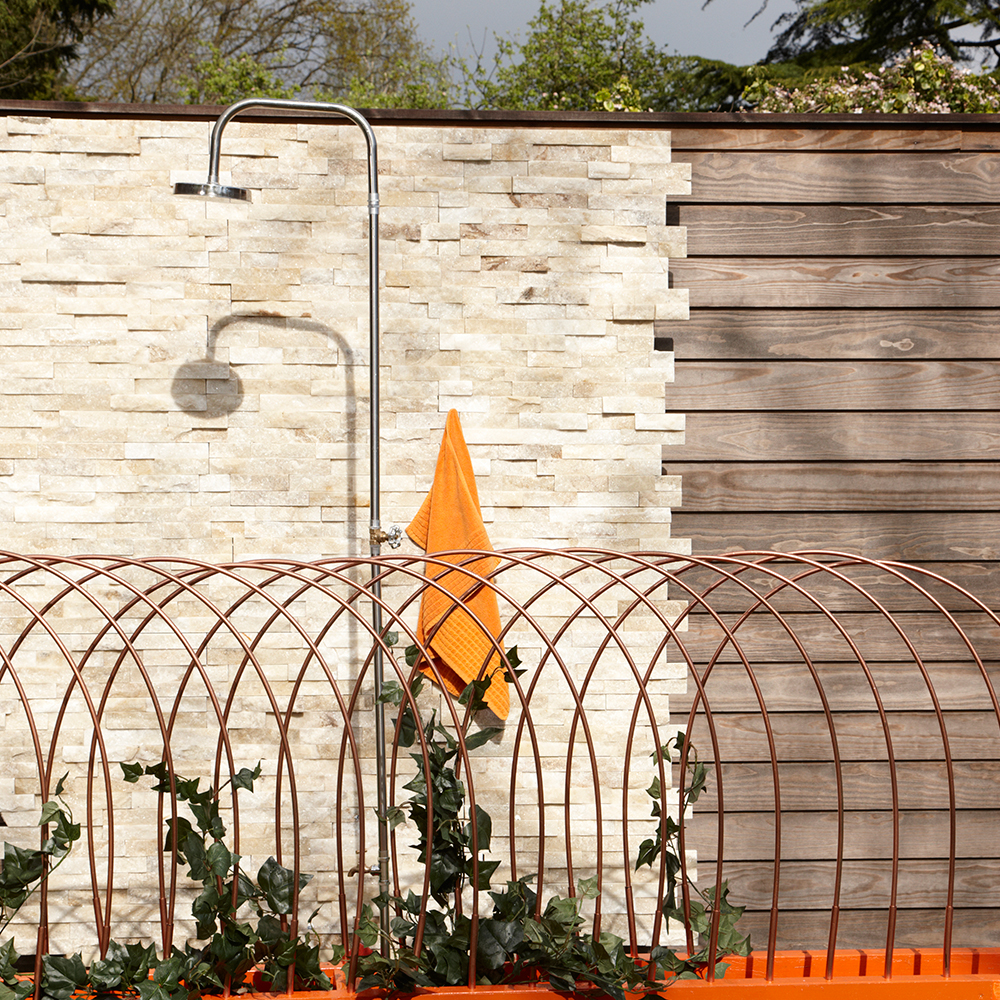
For a unique take on a garden fence, combine stone and wood in a Jenga-style arrangement. Here, this has been applied not just for the effect, but also for practical reasons – stone will endure a good soaking from the outdoor shower far better than wood. With a garden fence like this, the emphasis is on quality natural materials with an innate beauty of their own.
30. Charm with a picturesque picket fence
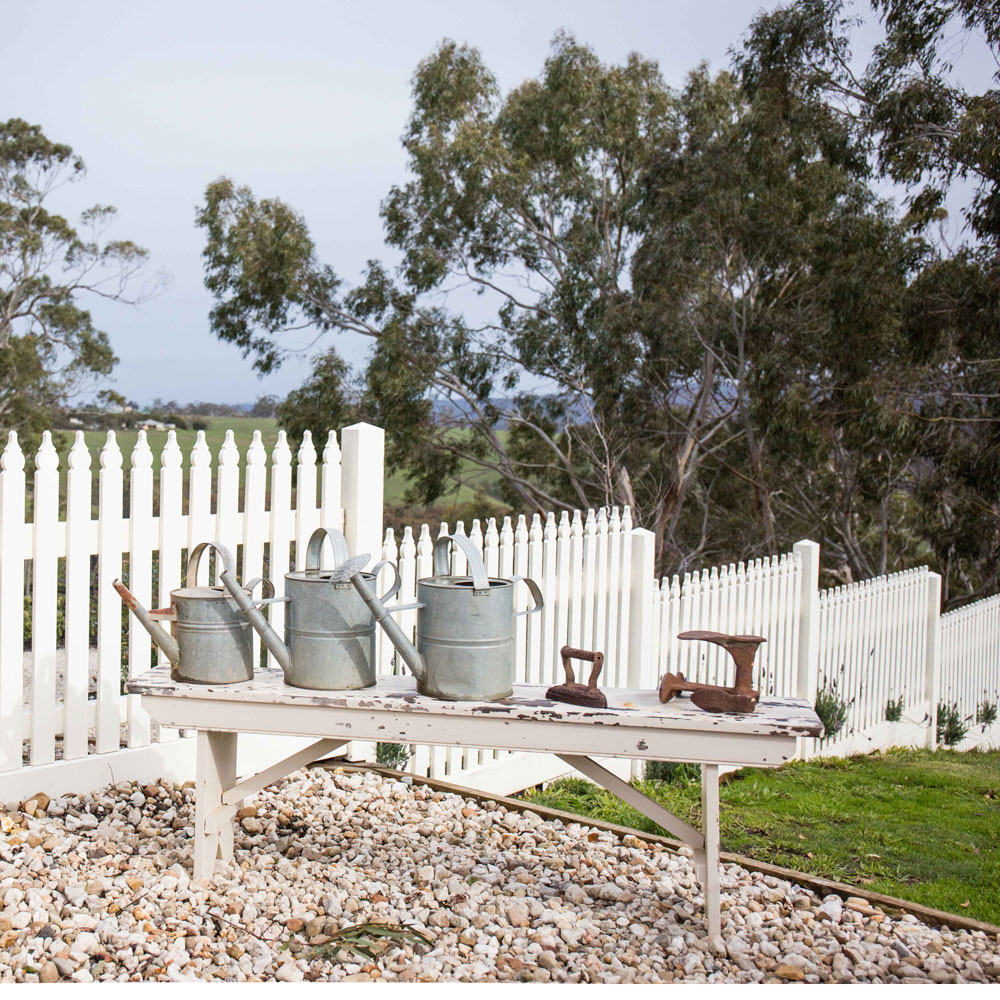
When it comes to garden fencing, you can't get much more idyllic than a traditional white picket fence surrounding the property.
A charming picket fence in white is ideal for both front and back gardens to create a picturesque classic garden enclosure for your home. As picket fencing only offers a low-level partition it might not be suitable for homes that require more security, such as households with children and pets.
31. Paint your picket fence in an array of colours
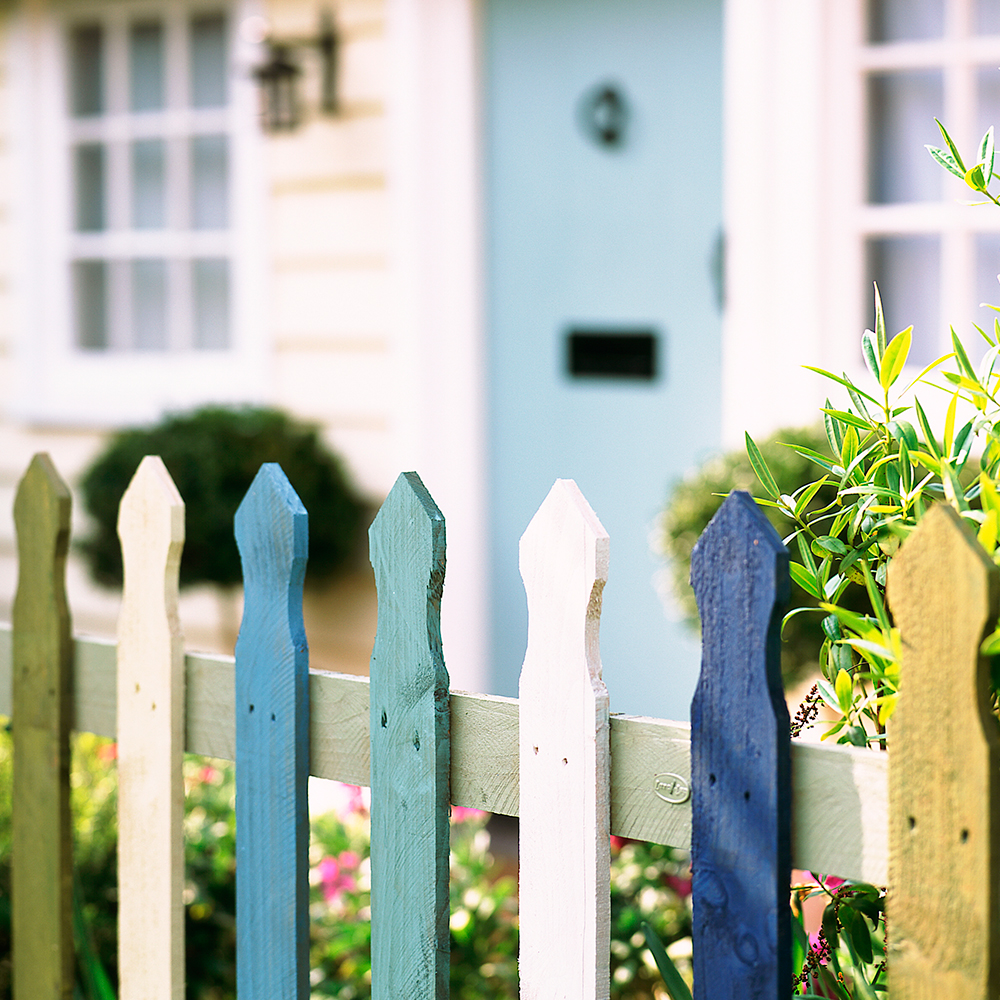
You don't have to stick to a white picket fence – when it comes to painting, the options are endless. 'The main benefit of picket fences is that they are low in cost and easy to customise and paint, so you can easily change up the aesthetic as needed,' says Thomas Goodman from MyJobQuote.
This design has been painted in colourful shades that make passers-by feel that bit happier. We all dream of a white picket fence, but if you're lucky enough to have one, why not take the plunge and go for something a little more daring? Paint your fence in pastel hues for a pretty, rather than garish, look.
FAQs
What is the cheapest fencing for a garden?
'While we recommend investing in high-quality fencing with a long guarantee to avoid costly replacements in the future, there are ways to reduce costs initially,' says Leigh Barnes from Jacksons Fencing.
'First, check the height you need. Garden fence panels are typically 1.8 metres high, but slightly lower heights such as 1.65-metre panels are cheaper without being drastically shorter. However, ensure shorter heights do not compromise your privacy needs. Always include gravel boards underneath to protect the fence from rot and add extra height.
'Traditional or kit-form fencing like featherboard is built on-site from posts, rails, and pales. This type of fencing is generally the most cost-efficient, allowing you to order exact quantities to avoid wastage. Remember that it may take longer to install, so add time.'
What kind of fence is best for property value?
'The best fence for property value is the classic wooden fence,' says Simon Wardle from Armstrong Cheshire. 'They’re easy to maintain, have a long lifespan and help with curb appeal. Each panel or section is easy to replace, too.
'A 2016 survey by The Telegraph suggests a well-maintained garden with premium fencing and sheds can increase a property's value by approximately 20%.
'Alternatively, an iron fence at the front of the property will enhance curb appeal and potentially increase property value.'







